3. Envisioning Kinship in Mass Capture
This chapter looks for ways to envision kinship in mass capture. Because the photographs in this archive are almost always of men, posed singularly in what we now understand as the generic form of the identification photograph, photographs of women and children, and sometimes even of whole families, stand out as breathtaking exceptions. And yet, the reprieve that these photographs offer from the overwhelming loneliness captured in the others is itself problematic. Not least, of course, because they are, in their exceptionality, evidence of the way in which the Chinese Immigration Act prevented the vast majority of Chinese migrants from being with their families. Because there is so much loneliness wound through this archive, it is hard not to look for relations, for evidence of kinship and family, for something more than the devastation of people separated from their loved ones. Thus, in this chapter, I will take up how kinship can be envisioned in, and despite, mass capture. I argue that the CI 9 photographs offer a different route to seeing Chinese families, in spite of the separations they endured. In so doing, I suggest trying to look at the CI 9 images as a series of collective portraits and as a different kind of family portraiture.
Looking for families by only examining conventional family portraits, where all members are grouped together in one image, risks missing the families present in this archive, even when their members are never pictured together. Some images of intact families pictured together are included in this archive due to the privileges of class. Only merchant families can be found in the same CI 9 photographs, and even then such images are very rare. To dwell only upon these atypical photographs would be to ignore the ways in which the CI 9 photographs demand looking for relation in ways that embrace what Hortense Spillers and David Eng, in different capacities, call “a feeling of kinship” (Spillers 1987, 76; Eng 2010, 196). As Spillers argues, the feeling of kinship is not divorced from material conditions, but rather is deeply tied to those conditions: “the feeling of kinship is not inevitable … it describes a relationship that appears ‘natural,’ but must be ‘cultivated’ under actual material conditions” (1987, 76). Under slavery, “‘kinship’ loses meaning since it can be invaded at any given and arbitrary moment by the property relations” (74, emphasis original). Spillers makes clear the pain of what it means to make family, to find kinship, out of material conditions in which the “connection between ‘kinship’ and ‘property’” enforces a perpetual logic of possible loss (75). The mass captured Chinese migrants on the CI 9s are not enslaved. And yet, the lesson of Spillers’s argument is one that has resonance for this book. Chinese migrant families endured forms of separation, and a very limited view of that separation can be glimpsed in the CI 9 archive. The separation of Chinese migrants from their families, of children from their parents, was systemic. Out of this system, I have tried to look for feeling, for the places and moments where kinship might still be found. For Eng, long histories of race and racism are central to the formation of what we call family, and making these histories visible means looking at how kinship is an affective formation that is deeply tied to the complex relation between history and memory. Although I was unable to trace visual evidence of alternative and queer forms of kinship in the CI 9 archive, I have tried to at least consider how something like a “ship brotherhood” or “ship sisterhood” might be a way of seeing kinship beyond that of the conventional family.
Mass Capture envisions kinship by looking for relations formed out of the grief of historical racism, and at the recuperative possibilities of relations formed out of the bonds of diasporic passage – as I will show through the images of the migrants aboard the SS Oanfa. In this exploration, I take a cue from the titular question of kinship and heterosexuality posed by Judith Butler in her 1994 essay, “Is Kinship Always Already Heterosexual?” Butler questions the “hypostatized heterosexuality … [that] has been the basis of the claim that kinship is always already heterosexual” (1994, 34). Instead, Butler suggests, “kinship loses its specificity as an object once it becomes characterized loosely as modes of enduring relationship. Obviously, not all kinship relations last, but whatever relations qualify for kinship enter into a norm or a convention that has some durability, and that norm acquires durability through being reinstated time and again” (37). The CI 9 archive offers a view into the ways that kinship as an enduring relationship – whether that relationship is founded in hypostatized heterosexuality or loosened from it, such as in a shipboard brotherhood or sisterhood – is undercut by visual and bureaucratic practices. These practices include the handling and filing of identification photographs for family members and the refusal to recognize the intimacies of a bachelor society of men torn away from their biological families. To see kinship in the CI 9 archive, we also have to look at how conventional and unconventional forms of kinship were ruthlessly curtailed and denied.
Looking for this denial means unlearning the impulse to look for kinship relations when they are not there. Consider CI 9 nos. 20306 and 20307 (figs. 3.1 and 3.2). This pair of certificates is a major finding. There is no more than a handful of images of multiple people in a photograph in the entire CI 9 collection. Children, even babies, were most often photographed following the conventions of the identification photograph: alone. There are very few images of people photographed together, and these two photographs are the only ones I have found of a woman and a child together.
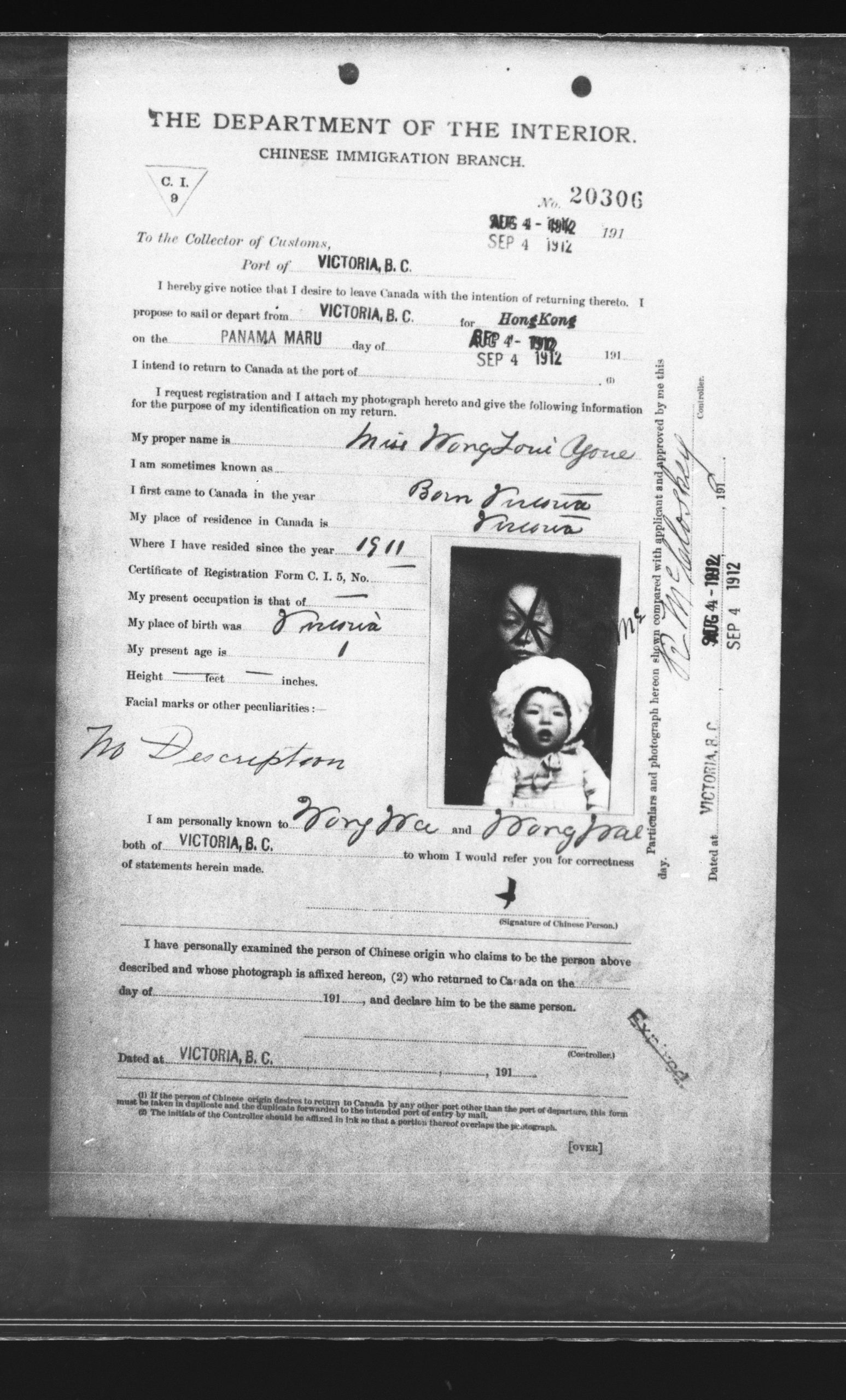
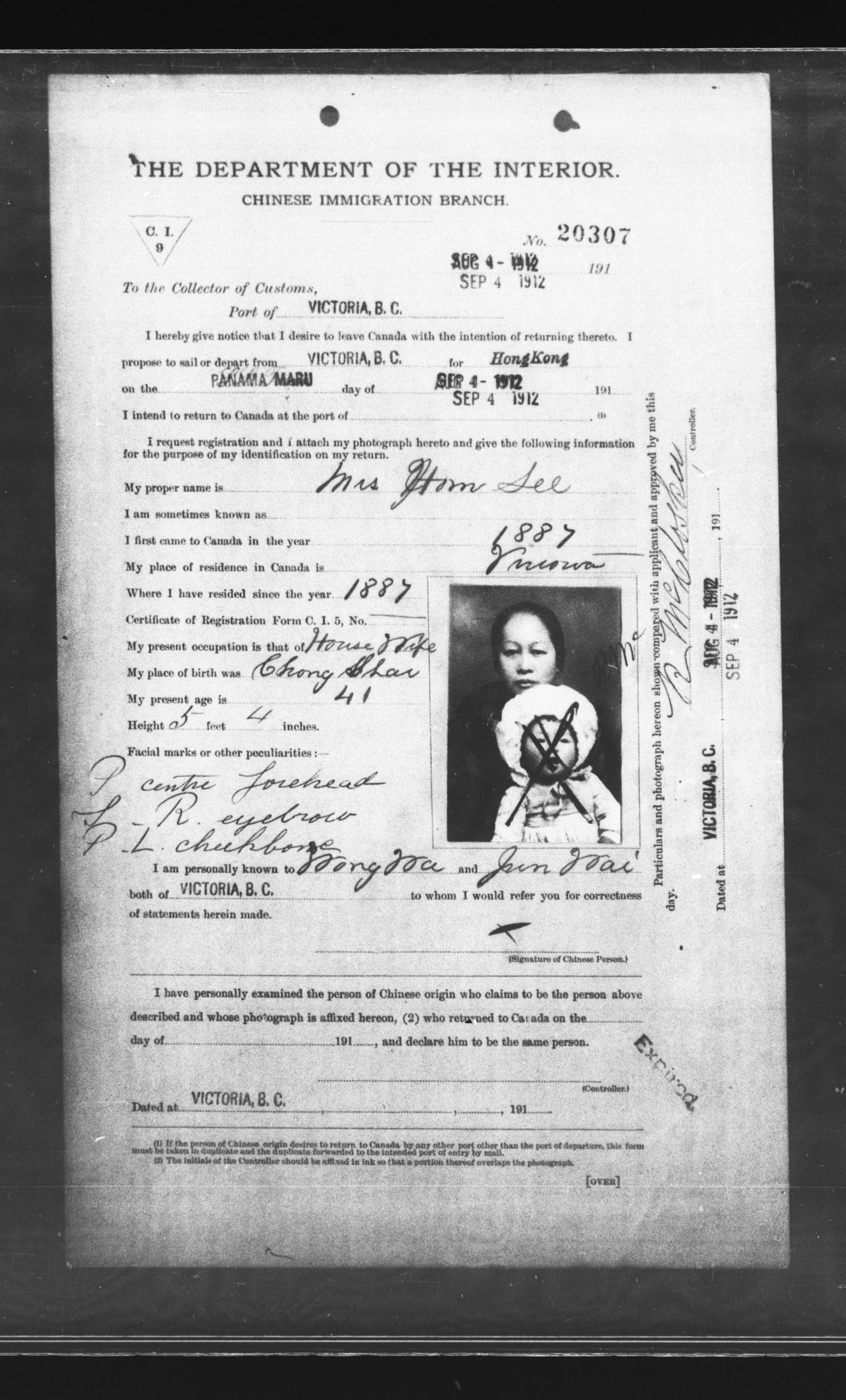
At first, it was hard for me to resist the desire to see these photographs as portraits of a mother and child. Setting aside for a moment the violence of the pen marks that cross out the face of the woman and then the child, what I initially missed in this pair of photographs is the violence of family separation that it records. In her discussion of family photographs from communities of people who have been persecuted, Kirsten McAllister writes of the “performative scripts” that family photographs elicit (2018, 169). I engaged in my own version of this scripting when looking at these photographs for the first time. For me, the photographs on CI 9 nos. 20306 and 20307 seemed like a reprieve, a welcome break from the pattern of single men in the centre of the frame. I was looking for relationships, for families, for signs that not everyone was alone. But I was also tripped up in this desire. It took me a long time to critically engage with these two photographs. I had to unlearn the desire to immediately presume that I was seeing an image of a mother and her child.
Looking again, and looking more closely, it becomes unlikely that these photographs depict a mother and her child. In CI 9 no. 20307 Mrs See declares her age to be forty-one years old. She came to Canada in 1887 when she was sixteen. Before she embarked on the Panama Maru for a trip to China, she was a housewife living in Victoria. She could not write her name in either Chinese or English and instead her signature is marked with an “x.” The certificate was issued on 4 September 1912. It is highly improbable that she is the child’s mother. She does not share a surname with the child. The certificate is stamped “expired.” There is no evidence Mrs See returned to Canada. If she did, it would have been after a prolonged sojourn of more than two years.
The baby in Mrs See’s lap is “Miss Wong Louie Youe.” She is one year old. She was born in Victoria. She also did not return to Canada before her CI 9 expired after two years. As the certificate declared, the child is “personally known” to Wong Ma and Wong Wai. Perhaps these are her parents. We cannot know. The mystery around this dramatic departure endures.
In this pair of certificates, kinship is formed and reformed. While the conventions of photographic portraiture would lead a casual observer to see these photographs as being of a mother and her child, they reveal instead a child who left Canada without her mother and in the care of a relative stranger. The baby is bound to Mrs See both by the sequential numbering of their certificates, indicating that they travelled together, and by being photographed with her. But these photographs on CI 9 nos. 20306 and 20307 are of a family torn apart.
The CI 9s are a form of record-keeping that memorializes the tragedy of separating a baby from her family without ever having to acknowledge the fact of this separation. Citing Hannah Arendt, Michelle Caswell connects the work of record-keeping to the willful ignorance necessary for perpetuating systems of injustice: “Records are the media through which procedures are routinized; records enable repetition, which leads to ‘the nearly universal ability to make any activity into a routine that deadens the awareness of what is to be done’” (2014, 53). In CI 9 nos. 20306 and 20307, folded into the routine and repetition of recording is a difficult personal history. McAllister argues that there are “social and ethical considerations of working with photos of families from persecuted communities” and that these considerations mean that “family photographs need to be understood not just as problematic normative scripts, but also as practices that families use to affirm their social relations and identities, in other words, to survive” (2018, 169–70). The photographs on these two certificates capture something of what survival might have meant for the child, if not also the woman. Surely, the decision to send Miss Wong Louie Youe away was based on a desire for a better life for the child. Thus, an image that might seem at first like a portrait of a familial relation is actually one of family separation. The image encodes a child’s separation from her mother.
This pair of photographs, CI 9 nos. 20306 and 20307, offers a poignant counter to an image of a woman and a child discussed by LiLi Johnson in her examination of Chinese head tax photographs in the United States. Johnson’s essay examines what are known as the Chinese Exclusion Act Case Files, created by the Immigration and Naturalization Service and held at the New York City National Archives at Bowling Green in Manhattan. Among the files that Johnson examines, there is one of Eleanor Sing Yee (fig. 3.3).
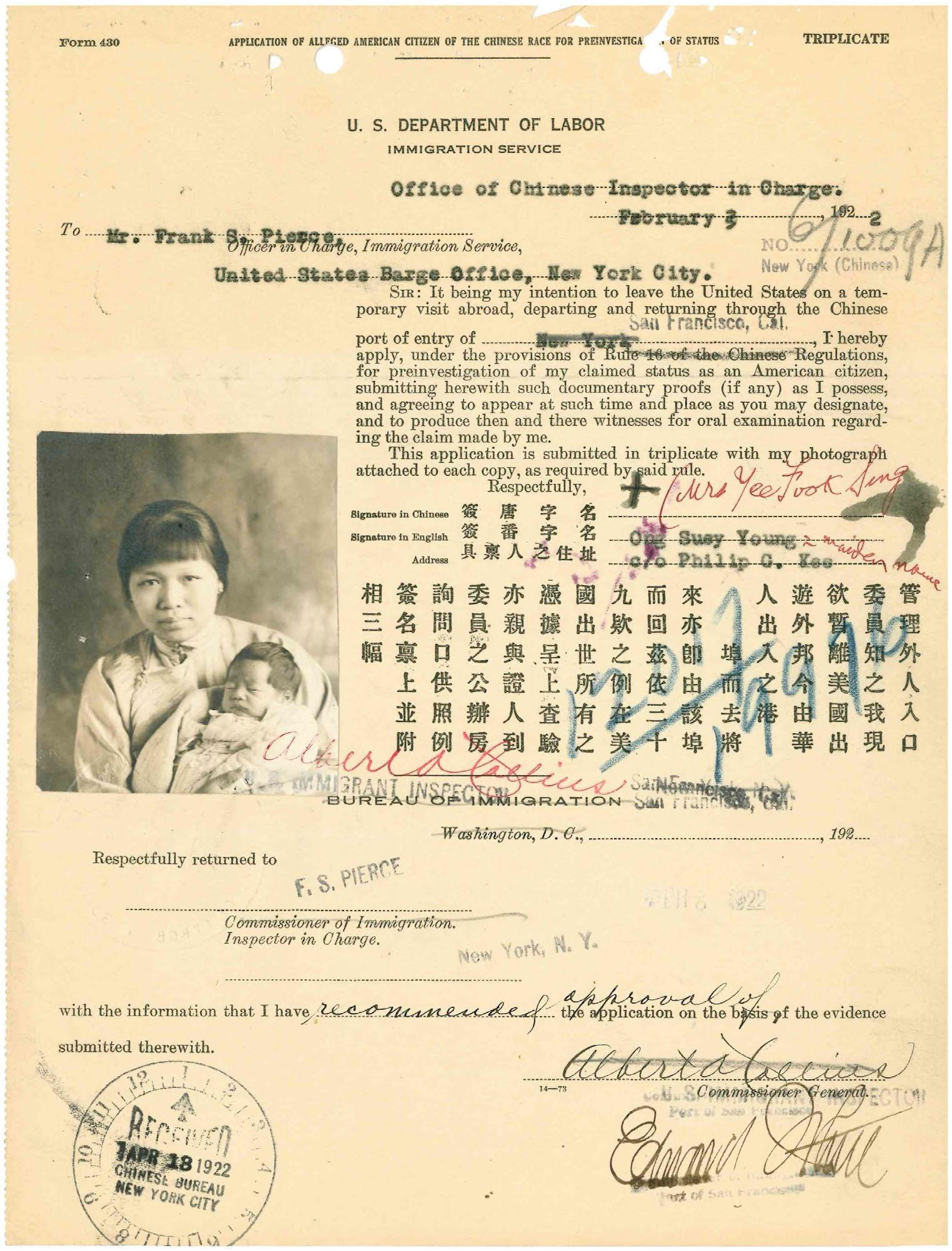
Here, a mother with her child: the very thing I wanted to see in CI 9 nos. 20306 and 20307. Johnson describes it as “a more conventional family photograph of a mother and daughter,” and goes on to note how this photograph “challenged the standards of the immigration bureaucracy” (2017, 111). Johnson notes that the need to identify the baby posed a challenge to the limits of the identification form in that “the logistical obstacles of photographing [the baby] alone” seem to allow for “the bureaucratic officials to make an exception” (114). How is it, she asks, that this “mother and daughter, disenfranchised by their racial identity gender, can represent the mounting anxieties of a bureaucratic system? In the case of Eleanor and her mother, Ong Suey Young, the identification photo was not created to accommodate infants. To have a photograph of two people used as duplicates of the same photo was outside the expected practice” (ibid.). But in the case of Mrs Hom See and Miss Wong Louie Youe, the CI 9 system had no trouble with a duplicate photograph. It needed only to engage in defacing both photographs in order to make the duplication work. While the Canadian head tax system often took its cues from the US approach to Chinese migrants, as this chapter will show, the treatment of the portrayal of kinship was often more cruel in the systemic denial and erasure of families and kinship relations.
At the most basic level, the CI 9 certificates refused to recognize kinship. There are blank spaces for so many details about each person on these certificates – age, occupation, CI 5 number, place of birth, facial marks – but a howling silence when it comes to family connection. These certificates deny family as a route to identity. The families that are not pictured, and the families that have been separated and broken by legislation and poverty, are also central to envisioning kinship under mass capture.
Families Ruptured, Kinship Interrupted
Mass capture is a technology of non-citizenship not only because it tracked migrants for the sole purpose of excluding them from citizenship, but also because it illuminates how these exclusions work at the level of families and kinship relations. We know that the head tax broke up families. In the CI 9 archive, we can actually see this severance at work. More than a mere record of families that have been separated and destroyed, or destroyed through separation, the CI 9s are the mechanisms of this separation. That is, the archive is a record, but it is also the means by which these separations occurred. The document is not a passive witness to this violence, but its active tool. Without these documents, migrants could not travel to see their families outside of Canada. Because the vast majority of Chinese migrants from this period did not have families in Canada, the CI 9s regulated when and how most Chinese migrants could be with their loved ones. The CI 9 is therefore a way to see processes of isolation and loss at work. As I will argue below, each individual certificate and each identification photograph, filed and sequestered from the others, is a portrait of isolation. The very form of the identification document and photograph are manifestations of the social and communal isolation that so many migrants had to live through.
In the CI 9 archive, there are two primary ways in which we can see the breakup of the family. First, the archive is made up almost exclusively of men. Second, when children, women, and families are pictured, these representations are themselves exercises in negation and excision. The treatment of the photographs of Mrs See and Miss Wong Louie Youe are stark in the deliberate and graphic way they negate the presence of the woman and then the baby girl. The agent could have differentiated the woman from the baby in so many other ways. Indeed, he need not have done anything to the photographs: anyone reading the certificate could immediately grasp the difference between the forty-one-year-old woman and the one-year-old baby. As my discussion of the Jung and Chong families later in this chapter shows, images of merchant families were not subjected to this disfigurement. There is a callousness to the marking up of the photographs on CI 9 nos. 20306 and 20307. It was not necessary. The decision to do it was arbitrary. It is a record of disregard and contempt, through a literal defacement of a woman and a child. There is something especially cruel about the treatment of these photographs given the scarcity of Chinese women and children in this archive.
That almost all of the people pictured in the CI 9s are men is not surprising. Still, seeing photograph after photograph after photograph, thousands upon thousands of Chinese men who lived and worked in Canada for decades, gives an inexorable visual weight to the loneliness of their experiences. Through her engagement with Allan Sekula’s arguments about the body in the archive, McAllister notes that “what archives lack in specific details about each photograph insofar as they have been torn from their social context of use, they are rich in potential for identifying patterns and relations” (2018, 179). The pattern that emerges out of the CI 9 photographic archive is one of immense isolation and the persistent deprivation of familial and kinship relations.
It has long been accepted that early Chinese migrants to Canada formed a “bachelor society” because the restrictions imposed by the head tax, and outright exclusion after 1923, meant that it was nearly impossible for any Chinese person, much less Chinese women and children, to migrate to Canada. As Arlene Chan recognizes in her entry on the Chinese Immigration Act for The Canadian Encyclopedia, the effect of exclusion in terms of diminishing the community was stark: “During the exclusionary period, fewer than 50 Chinese immigrants were allowed entry. The population decreased by 25 per cent, from 39,587 in 1921 to 32,528 by 1951.” The decline of the Chinese community in Canada emerges not only out of the fact of exclusion, but also out of the significant gender imbalance within the community. In his study of census data from this period, Peter Li reinforces Chan’s observations by paying particular attention to gender ratios: “In 1911, among the 27,831 Chinese in Canada, the sex ratio was 2,800 men to 100 women; in 1931, it was 1,240 men to 100 women among the 46,519 Chinese” (2008, 129). That is, women make up less than 1 per cent of the Chinese population in Canada during the exclusion. The effects of this huge gender imbalance was devastating for Chinese families on both sides of the Pacific.
Most of the Chinese migrants in Canada during this period had families but the law prevented these families from being reunited in Canada:
Not only did the law ban Chinese immigration, it also intentionally disrupted family life and stunted community growth … In 1941 there were 29,033 Chinese men in Canada, over 80 per cent of whom were married with wives and children left behind in China. Enduring this family separation, these “married bachelors” lived alone. A mere handful had the financial means to make a trip to China a few times during the exclusionary years to either marry or visit their wives and children. Whether or not they were Canadian-born or naturalized, they were not allowed to sponsor family members to join them in Canada. (Chan 2017)
This history of exclusion and its shattering effects on Chinese-Canadian families is likely to be familiar to even casual observers of Canadian immigration history. But, through the CI 9 photographs, it is possible to see what a bachelor society looks like at the granular level of individual lives.
Indeed, I want to suggest that the CI 9 photographs should be viewed collectively, en masse, as a portrait of the Chinese-Canadian bachelor society. Such a viewing disrupts what has been the more typical depiction of the bachelor society, which is centred on groups of Chinese men, usually in the context of their labour. This includes images of men working on the railway and in lumber camps, such as the images in figures 3.4, 3.5, and 3.6 from the Glenbow Archives.
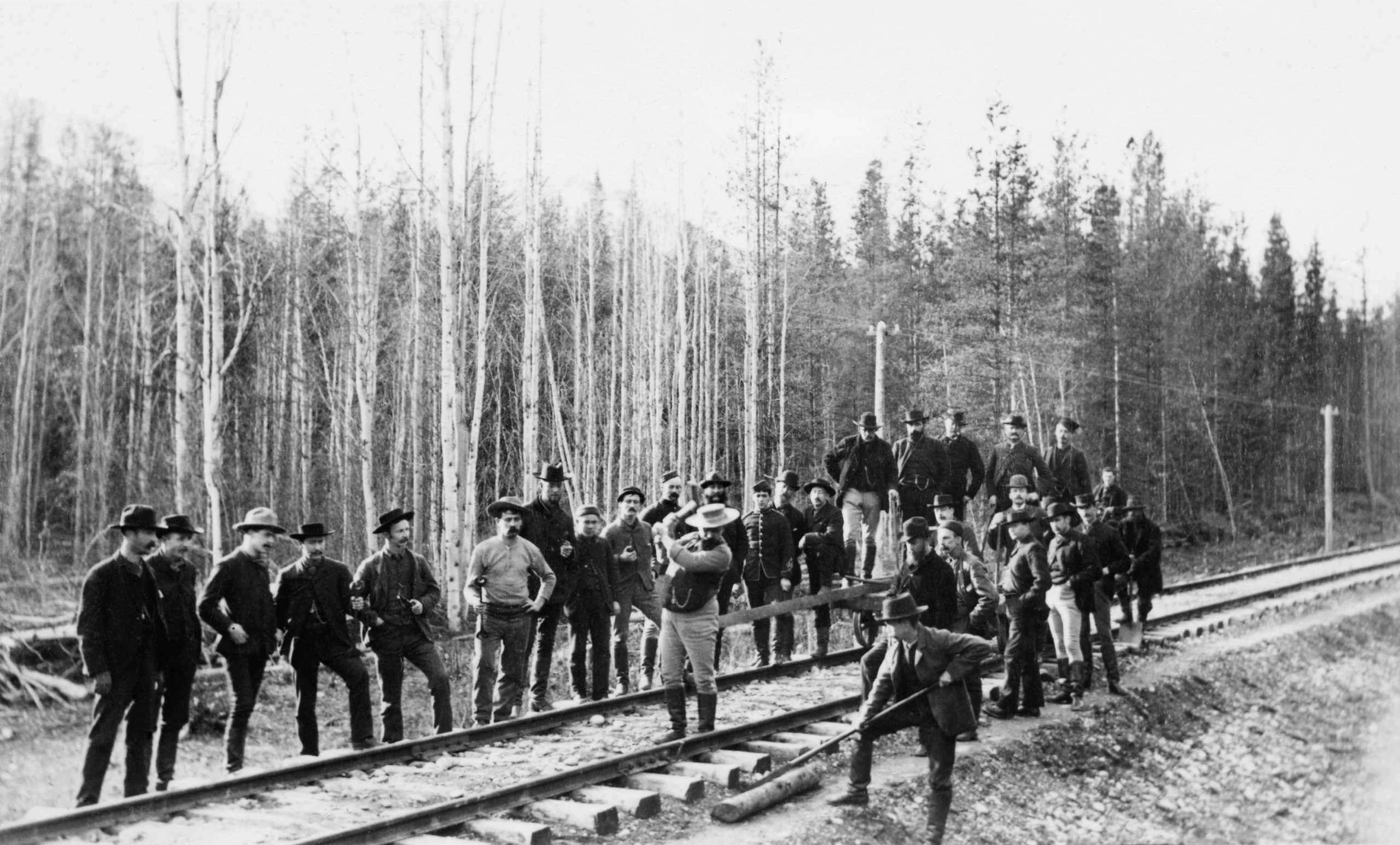
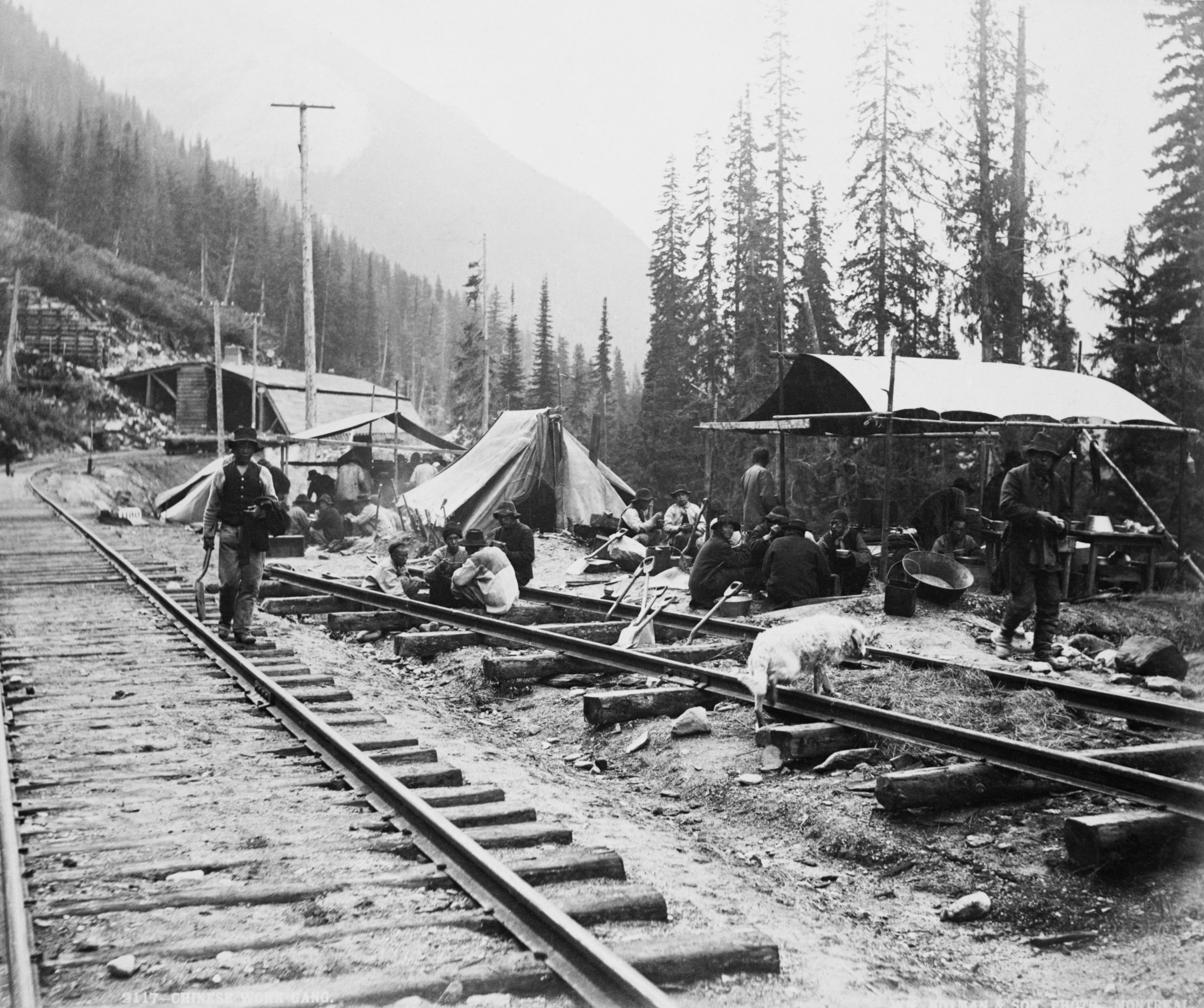
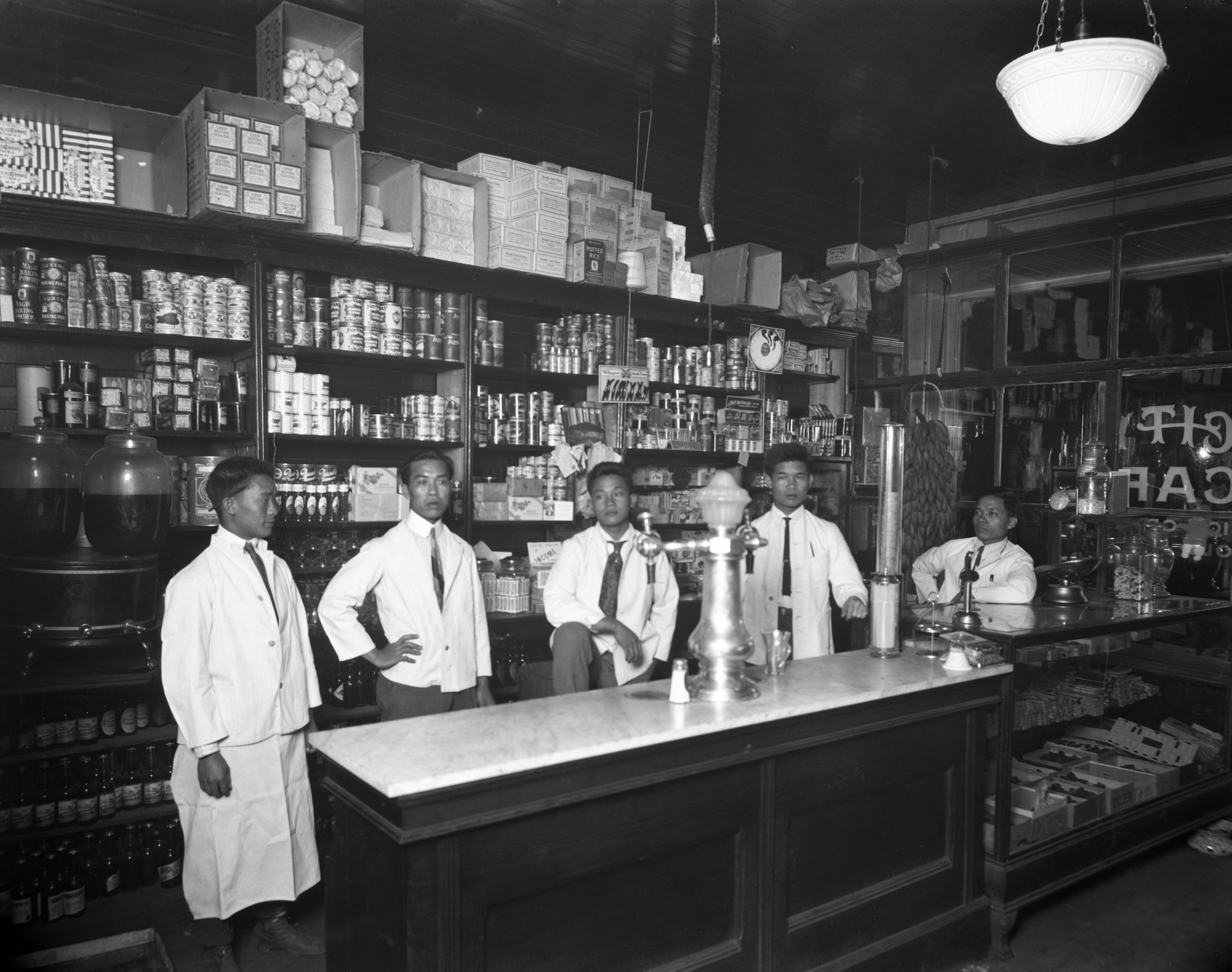
In addition to these images of Chinese labourers, there are also images of community organizations and social clubs such as hockey teams and the religious associations from this period, including one of the Chinese Nationalist League in Fort Macleod, Alberta, and of the Chinese YMCA Hockey Team in Calgary in 1917.
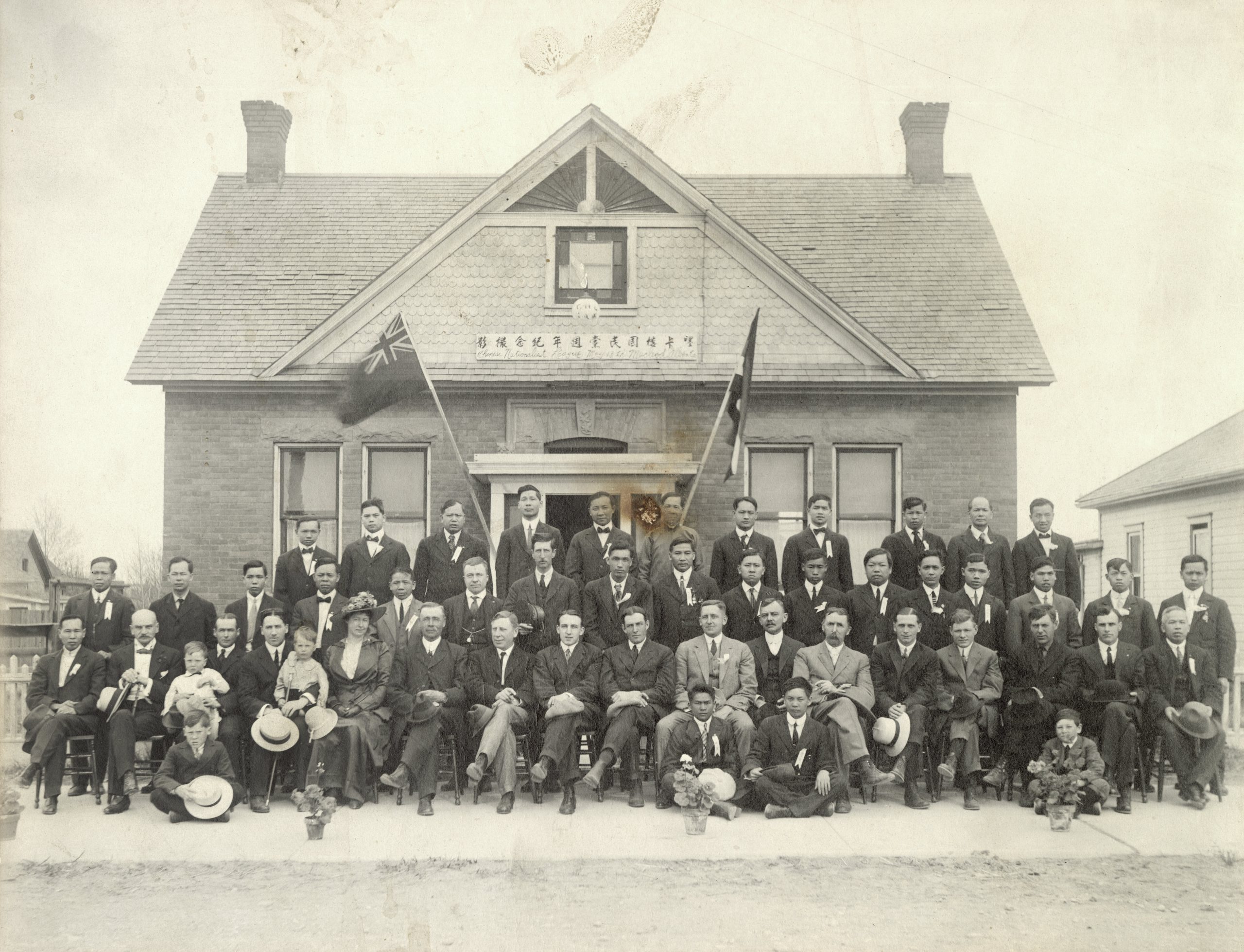
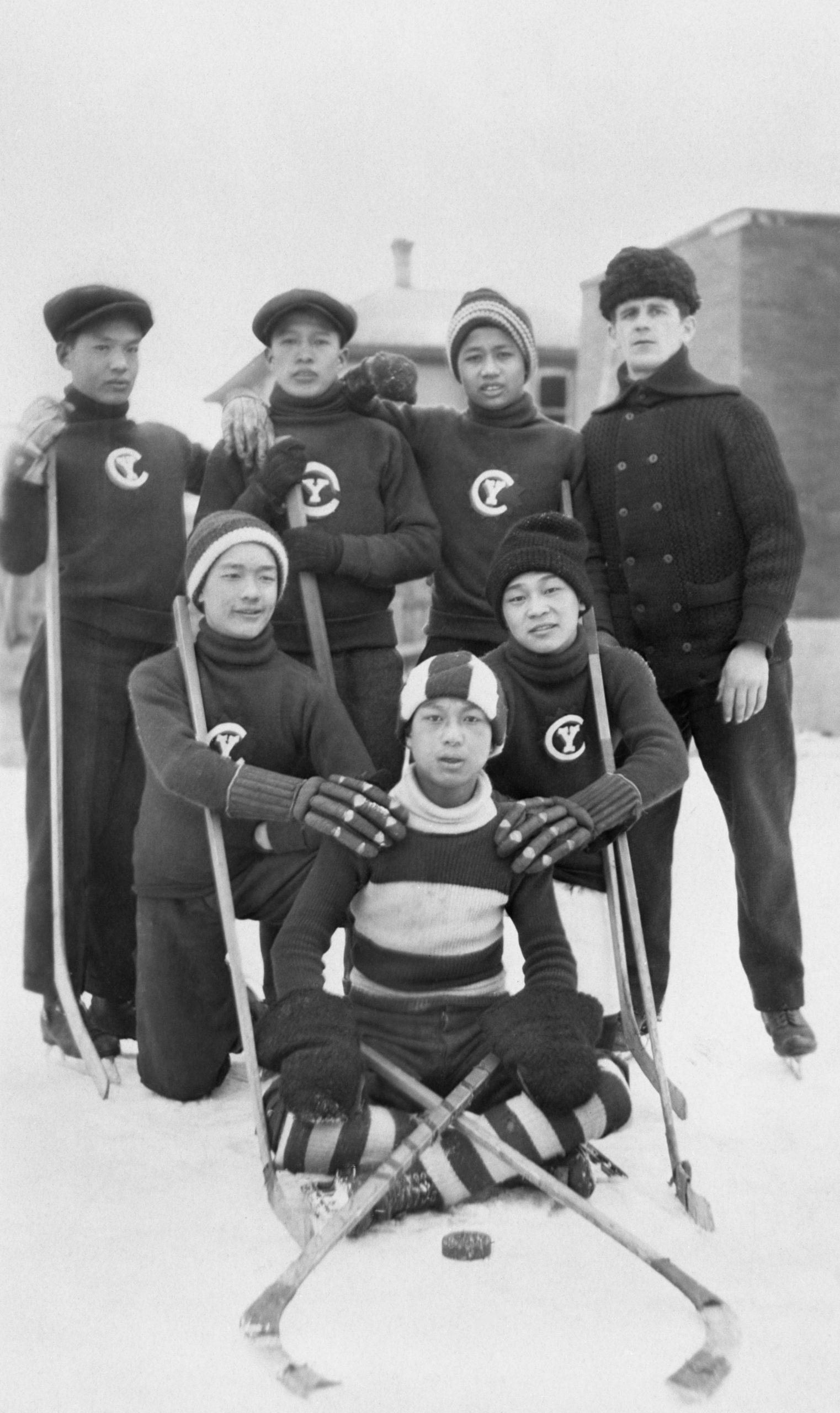
Even where group portraits did not exist in the first instance, there were composite portraits, such as the one of Chinese men living in Lacombe, Alberta, in figure 3.9.
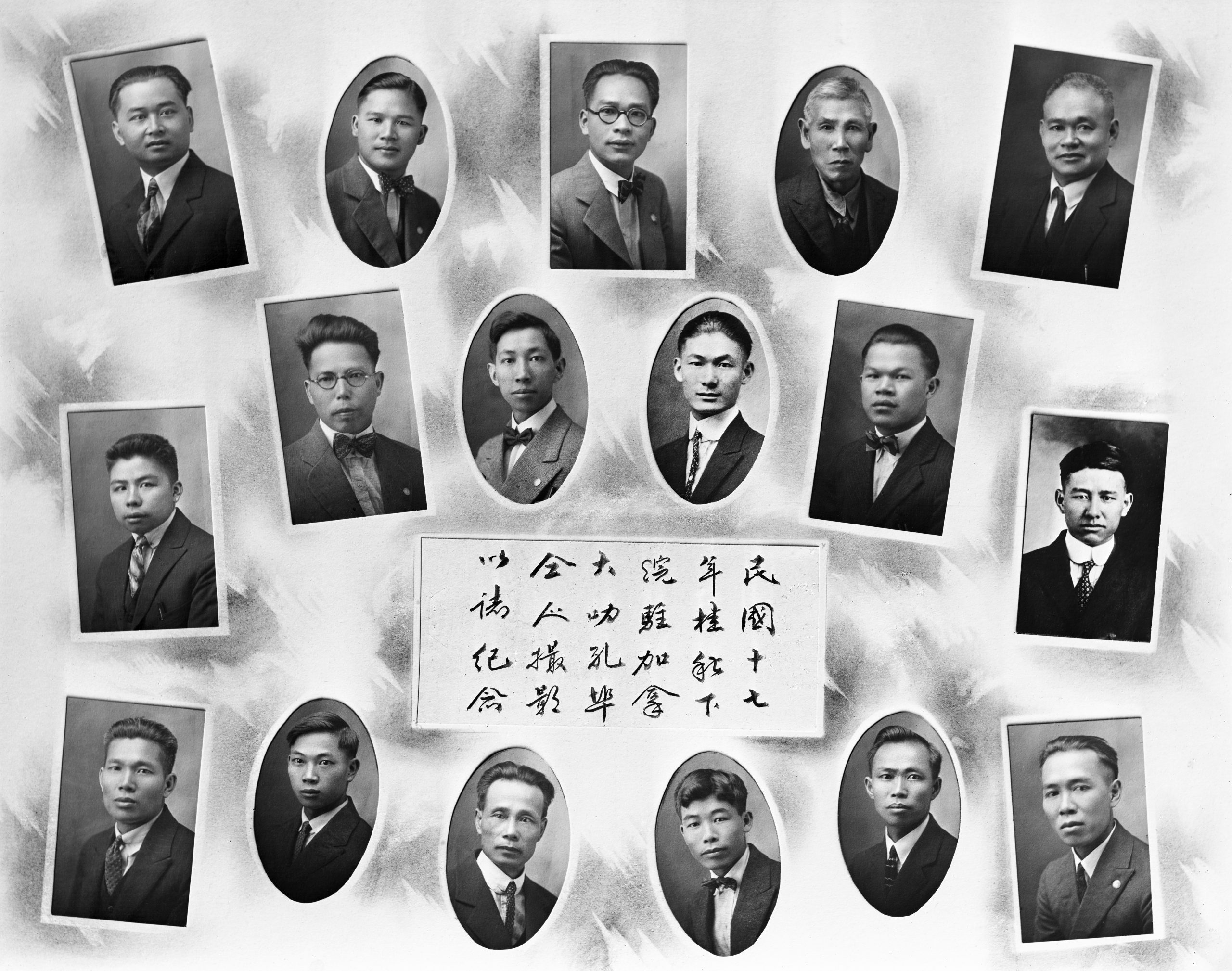
The Glenbow Archives, where this composite image is housed, notes that “the caption indicates that these are people who live in Lacombe, Canada, and provides a date based on the Chinese year. The photograph is meant to be given to someone as a souvenir.”
These group images capture the ways in which Chinese migrants made and found community for each other out of conditions that were otherwise extremely isolated and lonely. Still, focusing on these images as emblematic of a bachelor society risks underestimating the social segregation to which so many Chinese migrants were subjected. Not only were Chinese migrants often segregated from the rest of society, they were also often separated from each other.
Reading the mass of these Chinese head tax photographs collectively as another kind of portrait of the bachelor society allows us to more fully visualize the isolation of Chinese migrants during the head tax and exclusion period. It is not just the absolute volume of these individual images, one Chinese man after another, but also the form of the images themselves. As I discuss in chapter 2, the identification photograph exceeds the limitations of its genre. The boundary between a portrait and an identification photograph is often mutable, and, indeed, an examination of Chinese ancestor portraits reveals concordances between honorific and repressive photographs in the context of Chinese portraiture.
Taking up these identification photographs in terms of how they exceed the limitations of the genre means not only seeing beyond their repressive state function, but looking at what they show, at the level of form, about kinship for Chinese migrants of this period. These identification images are overwhelmingly portrayals of isolation. In each one, the subject is caught within the bounds of the frame. Each migrant is cut off from others, shorn of contextualizing and humanizing elements of sociability that the group images gesture towards. Here, in these thousands of identification photographs, the subjects are not visually situated in terms of their work. They are not pictured in the midst of others. Alone, almost always without props such as furniture, books, and other symbols of a place in a social world, the subjects of these images are cut away from each other by the very form of the image. While it is true that identification photographs are, by their very nature, images of individuals cut off from others, the photographs on the CI 9s are particularly notable for their lack of variation and their adherence to the conventions of identity photography established by the mug shot. This consistency distinguishes them from the US identification photographs of Chinese migrants. As Anna Pegler-Gordon observes:
There was wide variation in the types of photographs submitted to and accepted by the [US] Immigration Bureau. Photographs presented to the Immigration Bureau came in all sizes and shapes: most were rectangular vertical portraits, but some had trimmed corners and others were shaped as arches or ovals. They were placed in various positions on the document: in the upper or lower corners, crammed sideways along the edge, or displayed in the exact center of the paper … The photographs represented a range of portraiture conventions from elaborate studio portraits to simple head shots. They incorporated aspects of Chinese and Western convention, and they presented their subjects standing, seated, facing the camera, or looking to the side. (2009, 44)
This variation in the US Chinese head tax photographs attests to the many ways in which Chinese migrants contested and resisted the constrictions of the demand for photographic identification (48). While Chinese migrants in Canada, as the previous chapter shows, also enacted their own contestations against this regulatory demand, the space in which they did so was much more restrictive. Unlike the US forms that Johnson and Pegler-Gordon examine, there was a clearly demarcated space on each certificate where the identification had to be placed. Only very rarely were there deviations from this spatial rule.
Such exceptions were made for the families of merchants. This can be seen, for example, in the images of the Jung and Chong families (figs. 3.10–3.14).
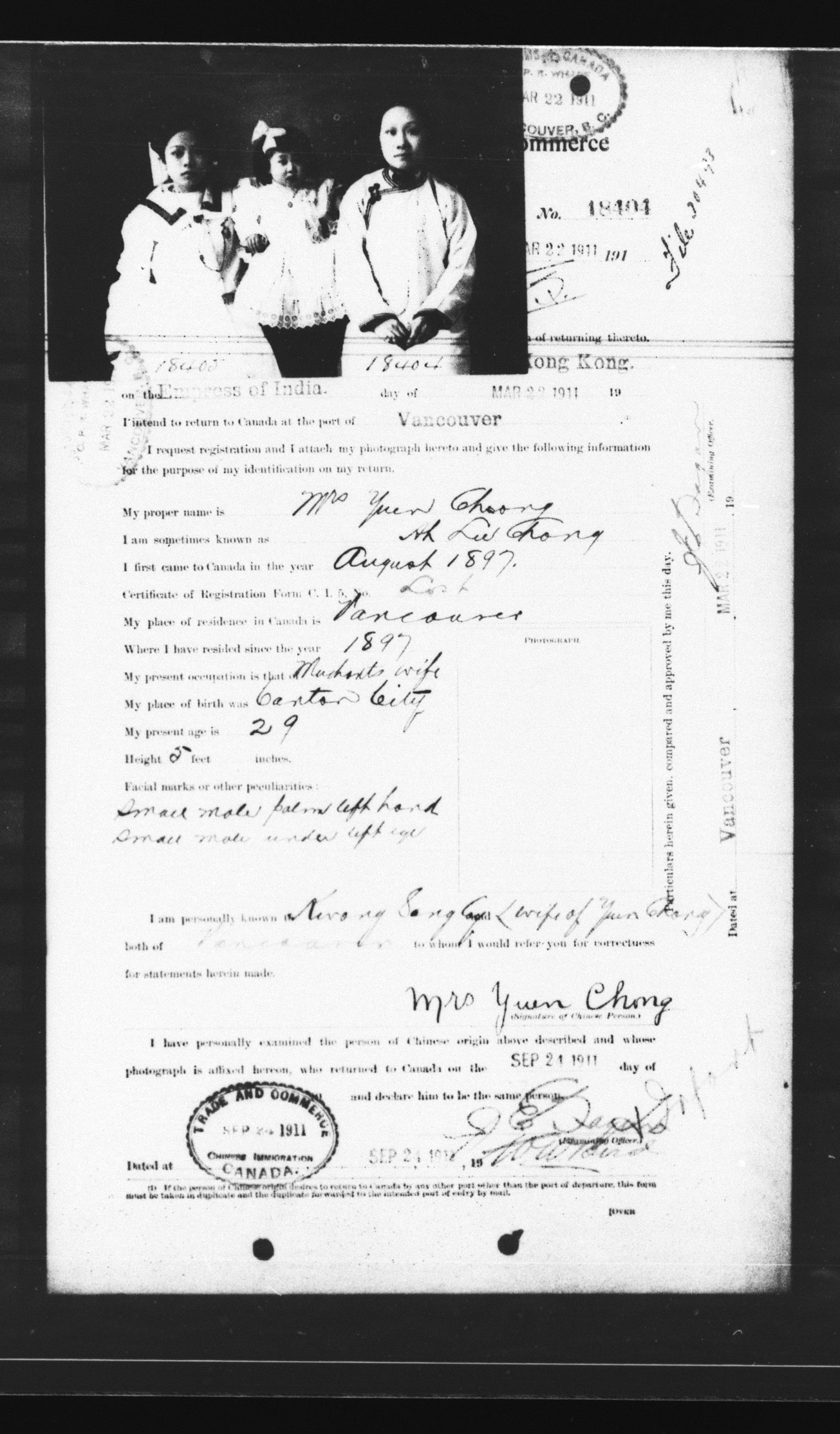
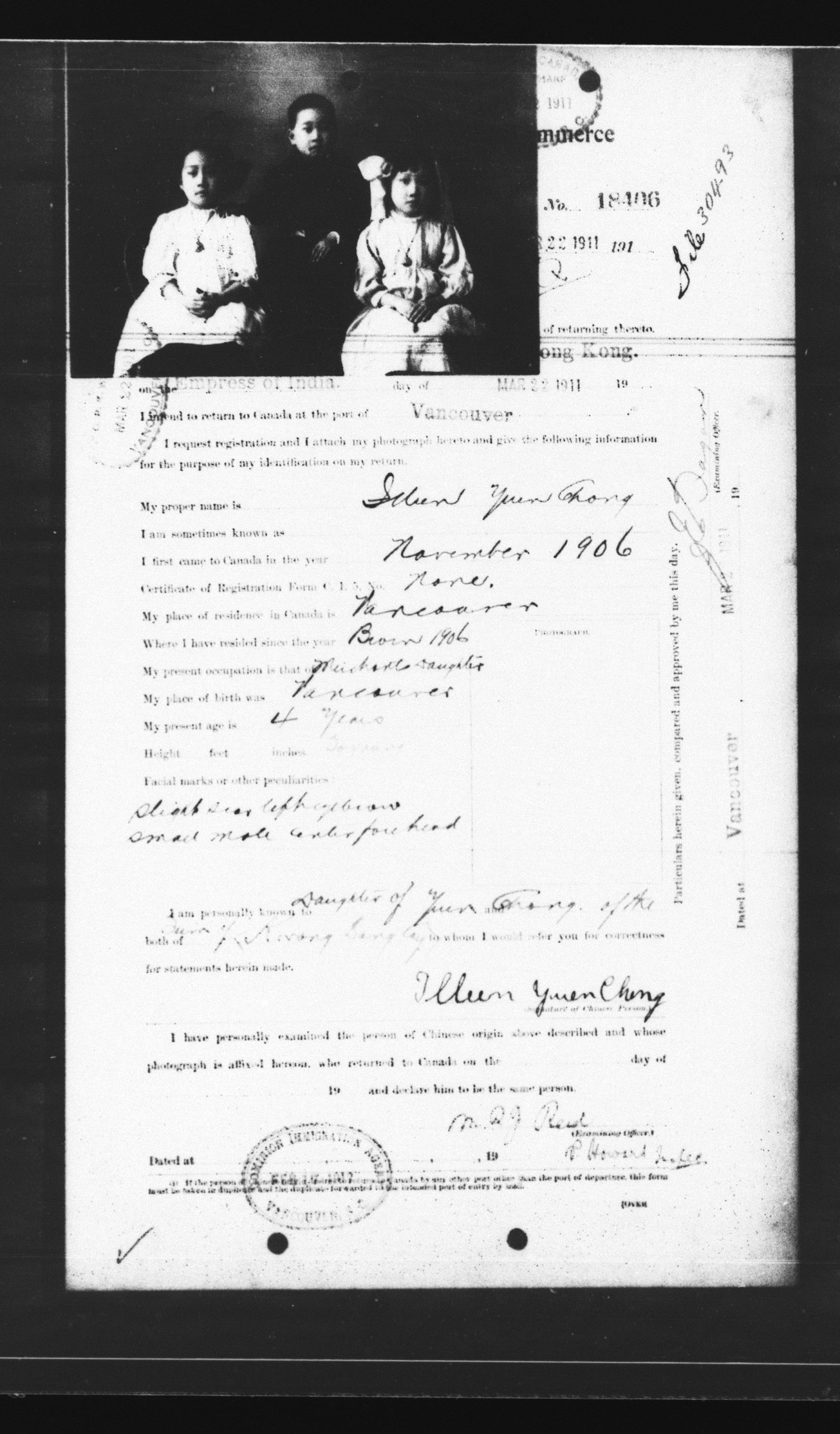
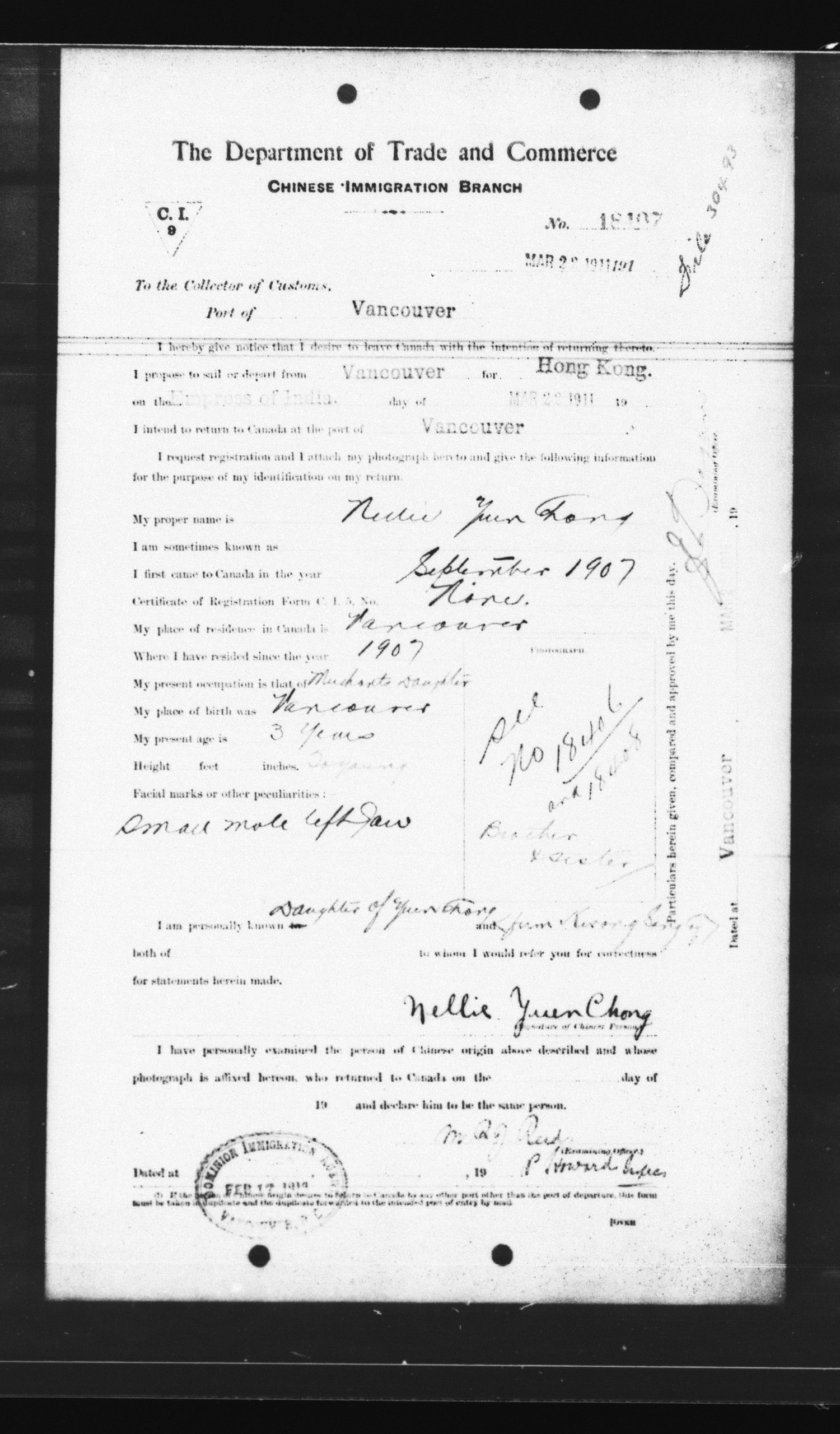
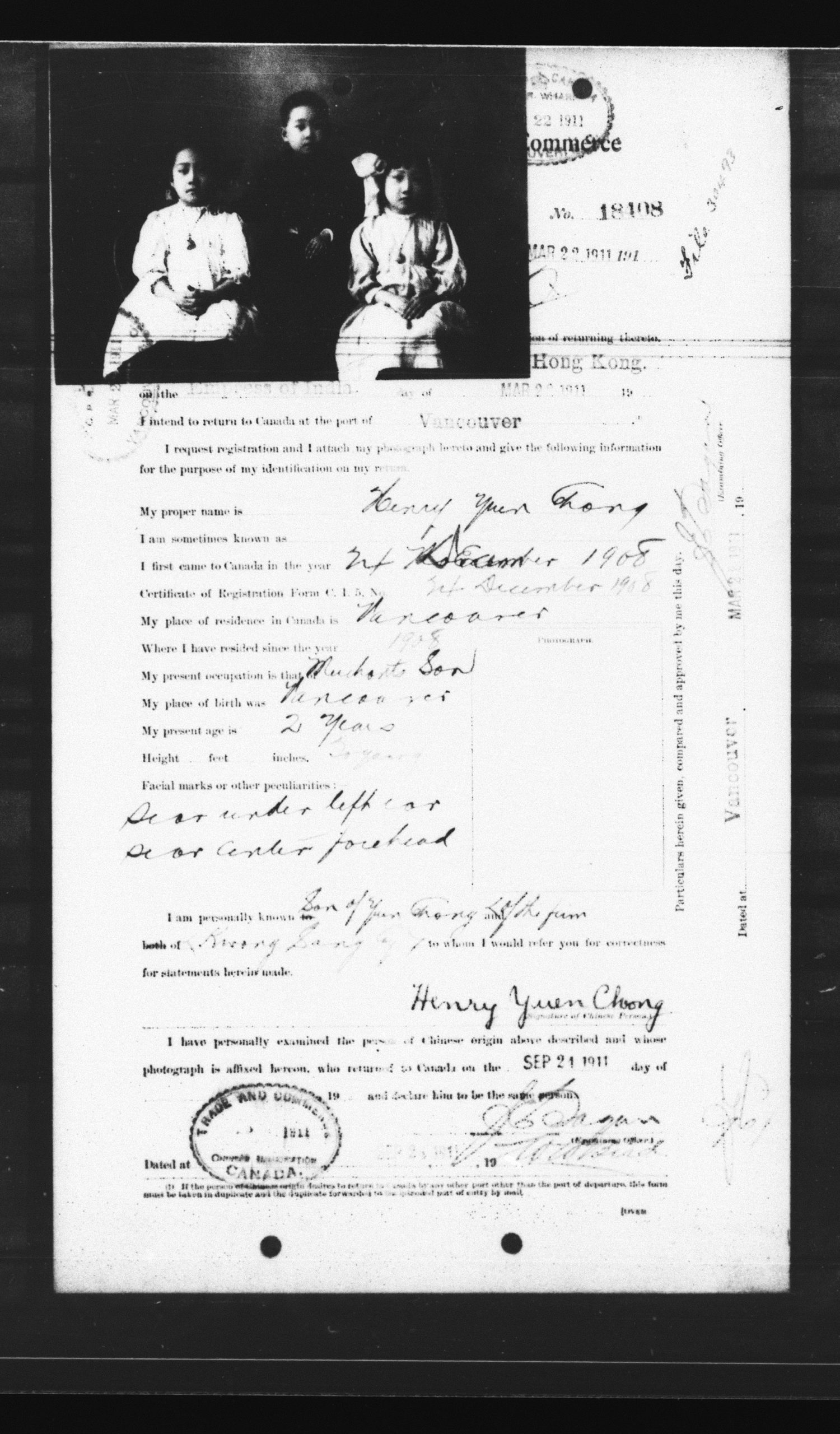
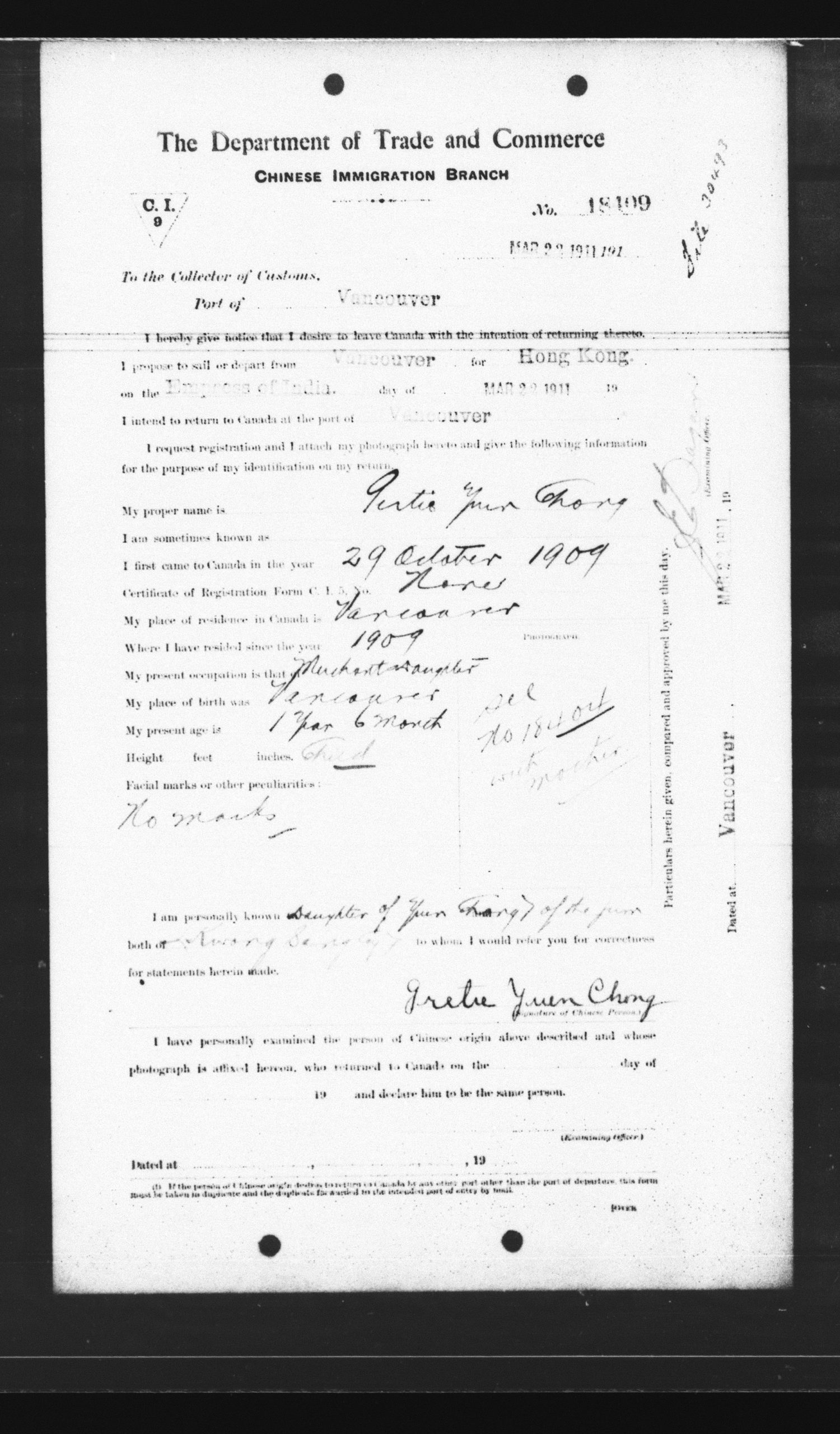
In this series, the Chong family is pictured in two photographs, both used twice. Together, these two group photographs form a family portrait of a mother and her five children, four daughters and one son. The CI 9s identify the members of this family as follows:
CI 9 no. 18404 – Mrs. Yuen Chong, 29
CI 9 no. 18405 – “Fooka” Ella Yuen Chong, 11, daughter
CI 9 no. 18406 – Suen Yuen Chong, 4, daughter
CI 9 no. 18407 – Nellie Yuen Chong, 3, daughter, no photo see 18406, “brother and sister”
CI 9 no. 18408 – Henry Yuen Chong, brother, 2 yrs old
CI 9 no. 18409 – Gertie Yuen Chong, 1 year and 6 months old, no photo see 18404
Even though the whole family is not brought together into a single image, these two photographs of the Chongs allow the viewer to see them as members of a family. No member of the family is pictured alone. And even though a single photograph is used on more than one CI 9, the subjects of the photograph are not subsequently scratched out in order to distinguish one from the other. Instead, the agent who is presented with their certificates engages with their photographs as most viewers of family photographs must – they have to look and try to figure out who each person in the photograph might be. These Chong family portraits thus minimize the harsh effect of the technology of mass capture in that the examiners of their certificates will engage in acts of viewing which demand seeing the people in the photographs as being related to each other.
The CI 9s for this family flout the conventions of the identification photograph in these certificates by either omitting a photograph altogether, or pasting the photograph onto the document such that the photograph obscures some of the writing. On CI 9 18405, the name of the outgoing ship has been completely occluded. While they are not exempted from the requirement for identification photographs, the Chong family is nonetheless permitted to take up a space outside the confines of the identification photograph. That space, with a rectangular outline clearly marked to the right of the certificate, is allowed to be left blank. Instead, appended to the top left corner of the certificate, they are outside of the regulatory frame. Unlike the certificates of Mrs See and Miss Wong Louie Choue from CI 9 nos. 20306 and 20307 (figs. 3.1 and 3.2), the Chong family does not have to submit a separate photograph for each member of the family. Some of the children (Nellie and Gertie) are permitted CI 9s with no photograph at all. The space where the photograph should be on their certificates refers the viewer to another certificate. They are allowed to be seen through their relationships with their mother or brother. While it is rare for any family to be seen in this archive, it is especially rare for the family to be pictured together in group portraits where the relations between one family member and another are clearly identified and acknowledged. Still, the Chong family is not entirely intact. The father does not appear in either of the two photographs, and the mother does not appear with all five of her children in either photograph.
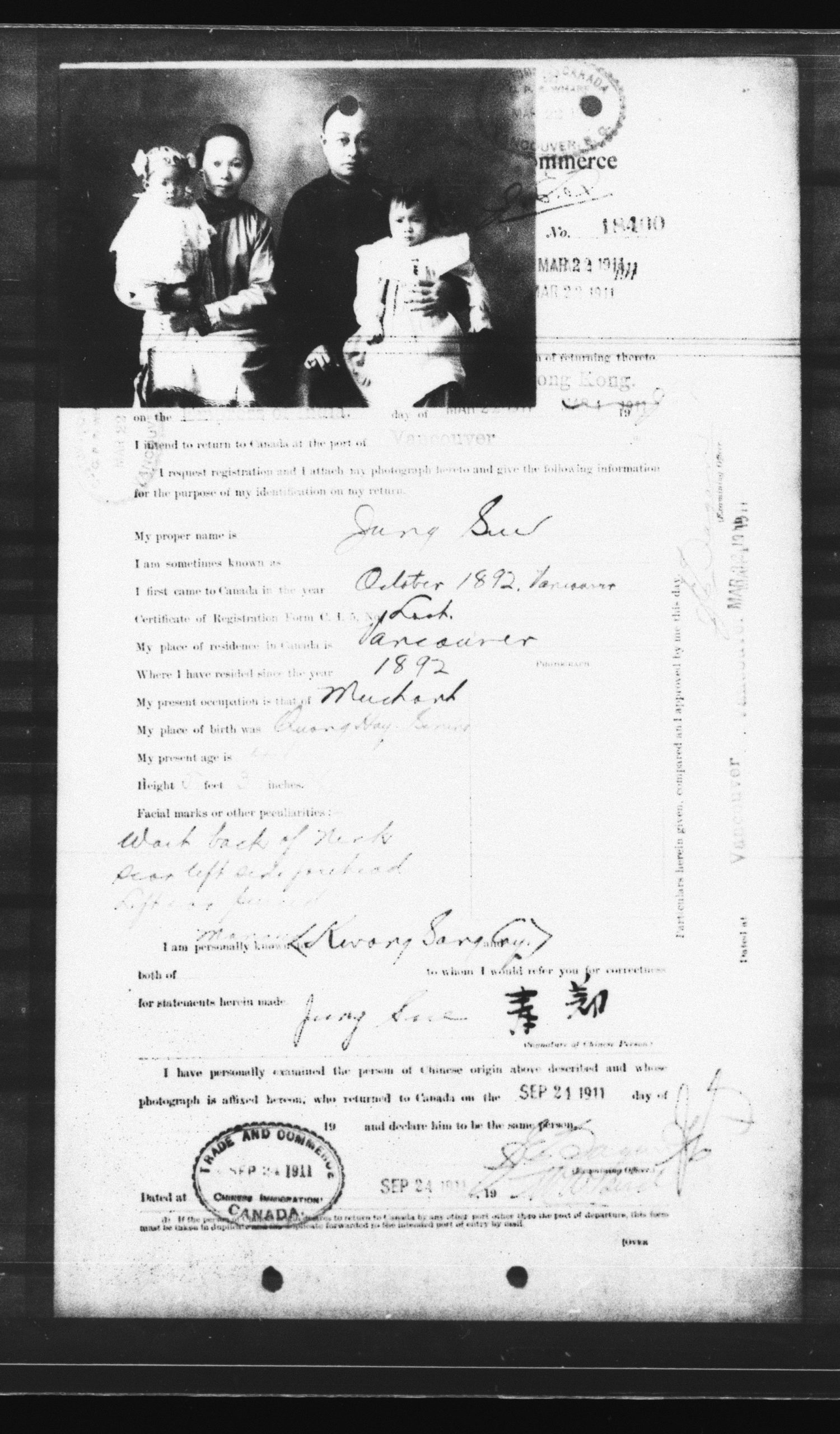
In contrast, consider the portrait of an intact family, the Jungs, in figure 3.15. As I will show later in my discussion of the Lawsons, a less-privileged Chinese migrant family headed by a man who was neither a merchant nor a diplomat, photographs like the one of the Jungs, where members of a family are pictured together, are the exception rather than the rule. Like the Chong children, the Jung children may travel with certificates that have no photographs at all (figs. 3.16 and 3.17).
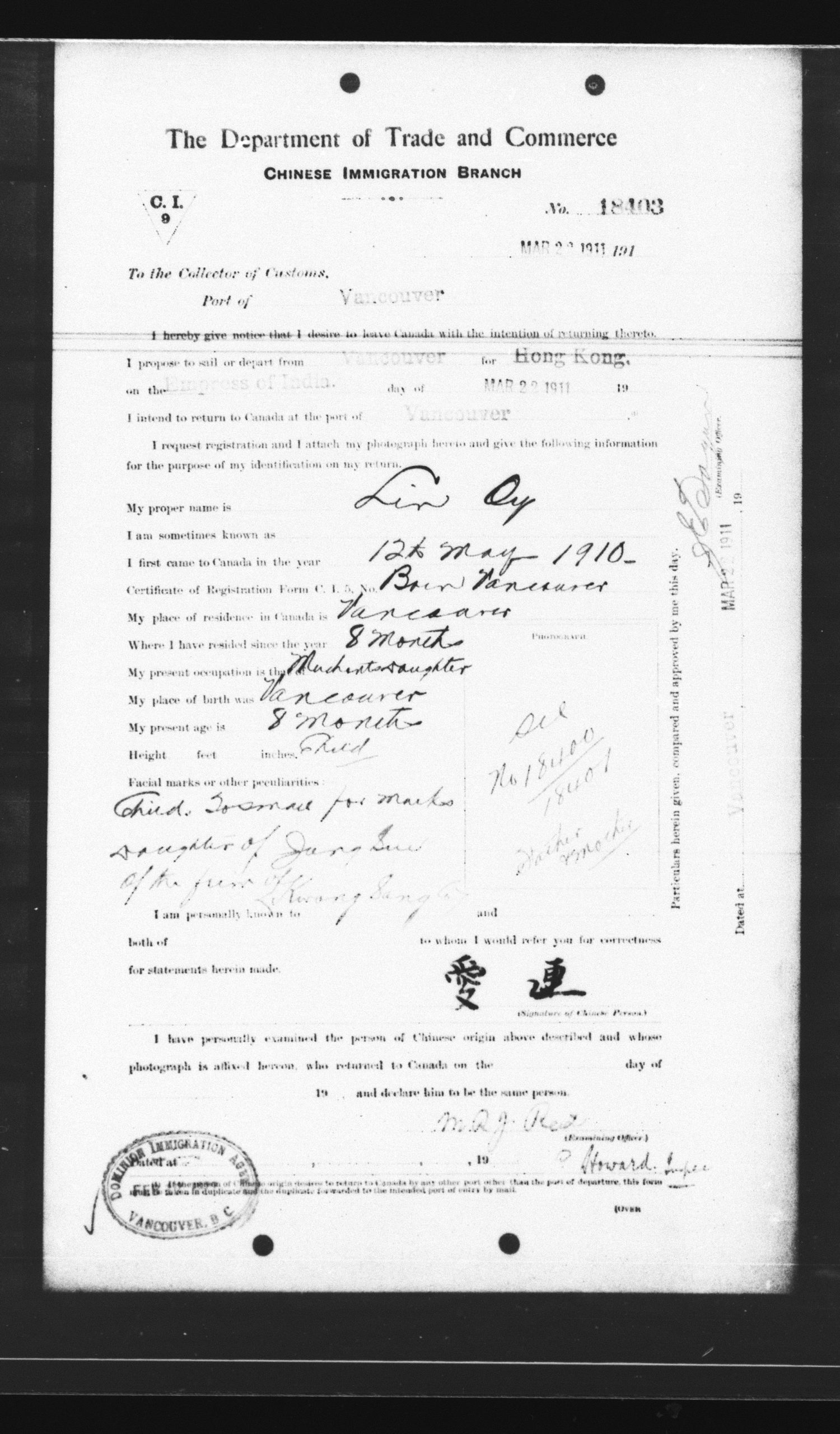
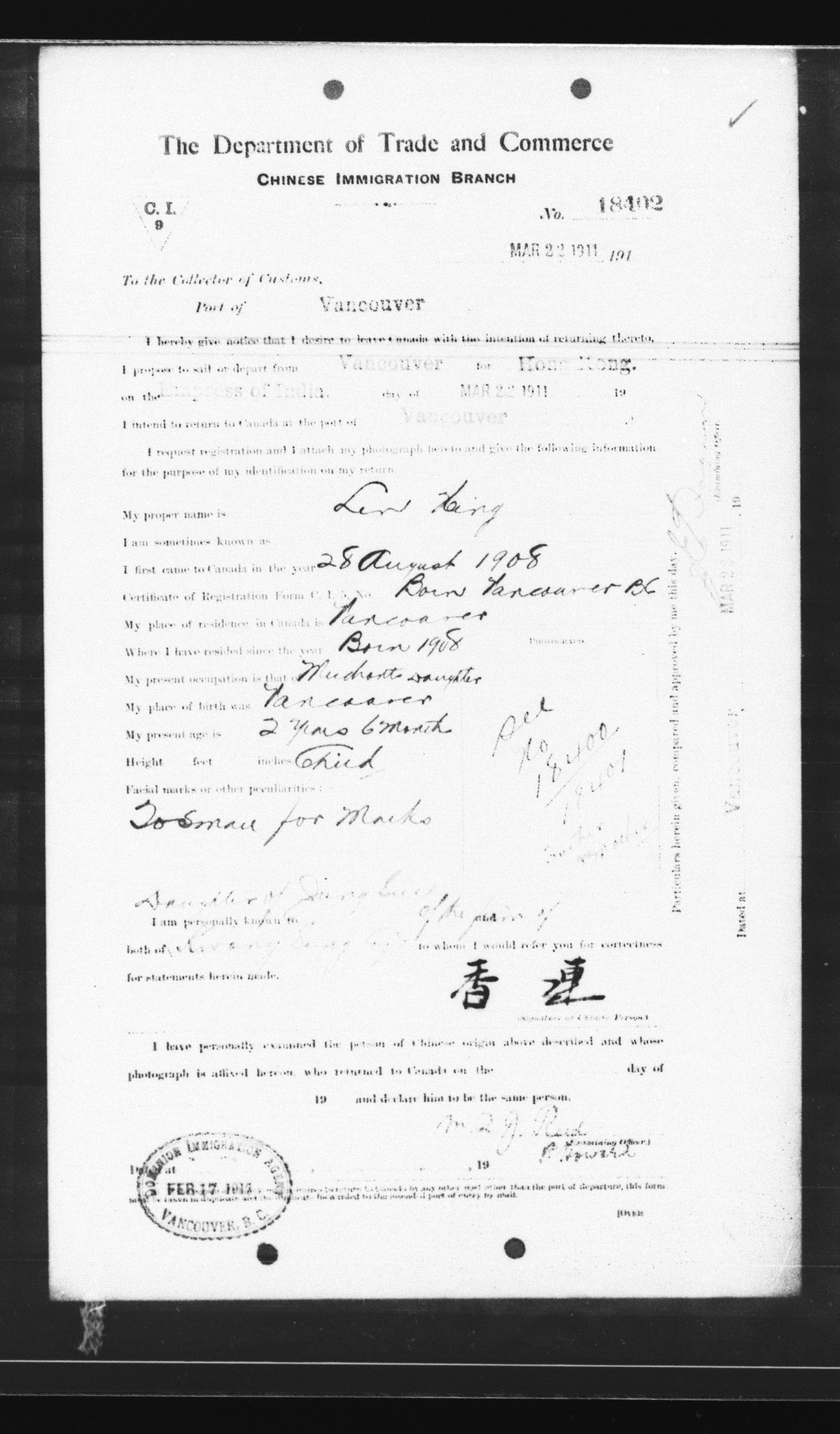
In lieu of an identification photograph, the children of this merchant were permitted to simply have their images cross-referenced with their parents’ certificates. Instead of having their photographs disfigured and literally crossed out, as was the case with Mrs See and Miss Wong, they are given the grace of a textual reference: “see no 18400/18401.” Like the Chongs, their familial relationships are acknowledged with the further note “Father Mother” in the space where the identification photograph should have been. Consolidating their relations as a family, the parents are pictured with their children on their CI 9s.
It is worth noting that even with the privileges afforded this family, their relationships with each other are still often obscured by the diplomatics of the form. In the case of the Jung family, the two children are either not given their father’s surname (Jung) or they have a surname (Lin) that they do not share with their father. If not for the note in lieu of the photograph on CI 9 nos. 18402 and 18403 for Lin King and Lin Oy, there would be no way to know that Jung Suk and Mrs Jung Suk of CI 9 nos. 18400 and 18401 are their parents. Without the written note that reads “see no 18400/18401 Father Mother,” the only way to understand that Lin King and Lin Oy are the children of the Jungs would be through the sequential ordering of the certificates where the children’s certificates follow directly from those of the adults. As my discussion of the Lawson family will show, attending to the numbering of the certificates can reveal family relationships that are otherwise completely invisible within the CI 9s themselves. Kinship relationships are not acknowledged or made evident in the overwhelming majority of the certificates in this archive. Instead, the CI 9 archive separated family members from each other and disavowed the relationships of family members even when they were travelling together.
Most often, the CI 9s capture a group of people who are singled out, specifically and systematically targeted by legislation, and sequestered from the sphere of citizenship because the law permitted and demanded their exclusion. This is not simply the isolation of one group of people from the larger society, but also of individual migrants from each other. Viewed as a kind of massive group portrait, the CI 9 photographs offer an image of collective isolation that is compounded by individual isolation. We need to see, or at least try to imagine, the CI 9 photographs en masse. We cannot just look at individual photographs and try to piece together, from a representative sample, an image of the group as a whole. I have struggled with this problem throughout my work on this archive.
It is a problem that, in a very different context, Ian Baucom identifies in Spectres of the Atlantic as the problem of postcolonial value. The central organizing event in Baucom’s book is the Zong massacre, an event that I briefly discuss in chapter 1 but which I now want to consider in depth. In 1781, the crew of the Zong murdered more than 130 African slaves by throwing them overboard. After a mistake in navigation, the captain of the ship believed that there would not be enough supplies to support all those on board. He calculated that drowning a number of slaves, and then claiming insurance on them as lost cargo, would allow for the journey to remain profitable. The resulting claim and the court battle based on the insurance company’s refusal to pay out the claim brought to light some of the horrors of the slave trade and was a signal event in the movement for abolition. For Baucom, the Zong massacre sets out a crucial problem of value that remains unresolved in our current moment.
Principally, it is the problem of the singular versus the exemplary. Each of the slaves murdered was singular. Each was an individual person with a specific history and identity. But, in order for their lives to have value in the actuarial sense, all of those differences must be flattened. Each murdered slave must be exemplary of another, an instance of the same kind or type of value. We now live with the legacy of a system of actuarial value that emerged out of, and was refined by, the slave trade. The whole of the insurance industry cannot, Baucom argues, be understood outside of the horrors of transatlantic slavery. This undergirding, the literal insuring of our entire contemporary economy, is problematic not simply because of the legacy of its emergence, but also because it puts into place a system of value that demands the evisceration of difference in the assignation of value. In this system, a life can only be valued insofar as it falls within a set of average values, which necessarily erases individual histories and specificities. For example, my life, insured, can only be valued in the ways in which it is typical within a limited range of controlling factors (age, country of birth, postal code, and so on). Baucom argues that “finance capital and its culture of speculation finds itself at once secured and articulated by that theory and the practice of insurance that exists to reexpress the (after)lives of persons and things not as themselves but as a suppositional, aggregate mode of being in the world. Insurance thus underwrites the hegemony of the average and the typical” (2005, 106). But it is not just the problem of averages that Baucom identifies. To insist upon the opposite, upon the necessity of the singular, is also to relinquish the political power of collectivity. We know about the Zong massacre because it was a case of mass murder. It did not draw public outrage because one slave had been thrown overboard. It comes to us because many people were murdered. It is a problem that persists. We live in the wake, as Christina Sharpe posits, of “the disaster of Black subjection” (2016, 5). The Black Lives Matter movement would not exist if one, singular, Black person had been killed by police. There would be no political movement over the unbearable but still individualized loss of Tamir Rice, or Eric Garner, or Sandra Bland, or Michael Brown. It is a movement because, in the United States in this moment in history, Black men are three and a half times more likely to be killed by police than white men. Thus, the problem of the singular versus the exemplary is also one of political weight. To insist on the singular is to also give up on the weight of the patterns, of the mass of an event, the profound collectivities formed out of the relationship between one tragedy and another.
In the fifth chapter of his book, Baucom tries to address this problem by turning to Gayatri Spivak’s A Critique of Postcolonial Reason. For Baucom, Spivak “stages the undecidability of the singular and the obligation of decision as a challenge: ‘Please decide …’” (2005, 166). Our choice is to decide what kind of truth the Zong massacre reveals. On the one hand, it “speaks to the episystemic truth of a global, worldly, situation.” That is, “to read the Zong as symptomatic, exemplary, typical of something larger, more abstract, and more total, to read it … as something worth reading, worth uncovering, worthwhile, because the utterly singular history it assembles can be seen to find its general equivalent in the history of the modern, is to risk grounding the value of such a way of reading in the very value form whose speculative and catastrophic triumphs this event brings to light.” Or, on the other hand, is the Zong massacre “something that maintains its cryptic silence, something singular and unverifiable” (168)?. That is, is it something so unique that any truth it holds belongs solely to its own place in history, that there is no equivalent to it, that it is not a symptom or a shard of something larger? In wrestling with these questions, Baucom notes that Spivak deconstructs the binary of the choice that has to be made, but it is still a choice. Please, decide, she asks.
This choice, between that which is exemplary and that which is singular, has haunted me. On the one hand, I want to attend to, and honour, each life on each certificate. Even if the subject’s identity might be, on some level, falsified. There is still someone there behind that number, that photograph, those details of residency and occupation. There is a desire to uncover as much of the story of each person on each certificate as possible. Indeed, such an investigation can yield enormous rewards: there are deeply complex and illuminating histories behind each certificate. But I do not want to lose sight of the ways in which these certificates, taken together, also matter. It is the mass of these documents that reveals so much about the devastation of this system of exclusion, as well as the resilience of the people who were subjected to its strictures.
Portrait of the Kinship of the Passage
How, then, to think of more than 40,000 certificates? How to see them and understand them as a collectivity? As a vast system of relation? Their number is not so vast as to exceed the capability of the human imagination. 40,000 is a number that can be imagined. For example, there are about that many full-time students at the university where I work. At the same time, I cannot ask you, the reader, to look at each and every CI 9 as part of the process of reading this book. Still, I want you to look at them collectively, all 40,000 of them, as a larger portrait of the devastating effects of the head tax. That is not possible within the scope of this book.
Although it is an imperfect solution, I would like to show you a “portrait” of one form of relation that emerges in the CI 9 archive: the kinship of the passage. The bonds of the passage formed in the holds of the ship have been a fulcrum of diaspora studies. For Paul Gilroy, the ship, and by extension the relationships emerging in its hold, form a “chronotope” of Black slavery:
I have settled on the image of ships in motion across the spaces between Europe, America, Africa, and the Caribbean as a central organising symbol for this enterprise and as my starting point. The image of the ship – a living, microcultural, micro-political system in motion – is especially important for historical and theoretical reasons … Ships immediately focus attention on the middle passage, on the various projects for redemptive return to an African homeland, on the circulation of ideas and activists as well as the movement of key cultural and political artifacts: tracts, books, gramophone records, and choirs. (1995, 4)
For Vijay Mishra (1996), the hold of the ships that carried indentured Indian workers across the Pacific made possible the emergence of the jahaji bhai, or ship brotherhood. Writing of the way in which the colonial process of documenting the disembarkation of Indian coolies was in itself a process of the reformation of kinship and relation, Mishra writes movingly of the passage as a rebirth, reinvention, and entry into history:
There was a collective drama as one post was left for another. Labourers waded through knee-deep water after reaching the lagoons on lifebuoys. The repetitive nature of this disembarkation meant that people could refer to it as a moment of origin or genesis in the new land. Apart from the bonding possibilities of this act, the colonial documentation of the event meant that for the first time Indian subalterns became historical subjects. Since … their names, their villages, their castes and their parents’ names were recorded on emigration passes this motley crowd entered for the first time the regulative history of the Empire. Yet there is no subaltern Marlow who has recounted the first encounter with these outposts of Empire, even though scattered and fragmented oral accounts of some indentured labourers have survived in folk stories and songs. All that remained was the memory of the passage and a loss that could only be sustained through the categories of myth. The sailing ship (and after 1880 the steamship) became as important a site for the purposes of legitimation as the motherland itself. The bonds created through the jahaji bhai (‘ship-brotherhood’) confraternity led to social configurations that were not unlike those of the village networks in India, but much more radical because this was the first space in which the Indian labourers had to face the reality of losing caste as a consequence of crossing the kalapani, the black sea. (429–30)
Of course, this ship brotherhood was also a sisterhood. As Miriam Pirbhai notes in “The Jahaji-Bhain Principle,” there was ship sisterhood that reworks the singularity of the fraternal experience Mishra depicts. Still, both Pirbhai and Mishra locate the experience of the passage, of the collective displacement, centrally in the construction of new forms of relation in diaspora.
In a reverse journey that remains nonetheless tied to the diasporic connection that Gilroy, Mishra, and Pirbhai uncover, the CI 9 archive shows the destruction and reformation of kinship relations in the journey away from the site of diasporic rupture. In the CI 9s, we can follow connections formed by migrants who are engaging in a doubled return – back to a putative “home” across the Pacific, and then, often, again to their lives in Canada. Where Mishra and Gilroy understand the shipboard passage from the space of origin as one in which diasporic subjects emerge out of the trauma of dispersal, the Oanfa portraits (see insertion.) show diasporic subjects who are ostensibly returning “home.” But, the homes to which they might return – and it is, of course, speculation that they are returning home – cannot be the same homes that they left behind. As each of their certificates reveal, they have been away too long for these homes to have stayed the same. Most migrants were away for many years. What is more, the restrictions of the Chinese Immigration Act meant that they could not be away from Canada for more than two years at a time if they wished to be readmitted. So the homes to which they were returning, if they were indeed returning home, were provisional. If the ship brotherhood and sisterhood of the voyage out is fundamentally a kinship borne of collective trauma, this passage of return cannot undo that harm. It may offer repair or alleviate the ache of losing family and intimacy, but it is not a reversal. It does not unmake the bonds that were formed on the passage out and the subjectivities forged out of the trauma of that experience.
Still, the bonds formed on the ship, crossing back eastward across the Pacific, should not be dismissed. The migrants aboard are not subject to the initial trauma of dispersal, but this crossing carries its own pain. Every person who has ever tried to return home knows this pain. Deep in your body, you know that there is no return. The home that you have left is no longer. The relations you had are ruptured. There may be repair, and there will be a different home, but the pain of those losses forges its own bond. Each ship in the CI 9 archive carries a community of migrants bound by the processes of mass capture where relationships and connections between people are broken, formed, and reformed. Later in this chapter I will show, in detail, the process of destruction and reconstruction of one family enfolded into this archive. But first, let me pause and ask you to consider with me the ship itself as a site of relation and kinship. In approaching the ship as a space of kinship, I am wagering a response to the question of postcolonial value that Baucom and Spivak pose. I cannot choose between the singular and the exemplary. I do not wish to choose. Instead, let us consider just one ship as both singular and exemplary.
I have created an online album displaying the CI 9s for every certificate-carrying passenger on the SS Oanfa, which departed from Victoria, British Columbia on 14 October 1911. These are CI 9 nos. 17903 to 18190. There are 286 migrants that have been issued CI 9s on this ship.
CI 9 nos. 17903 to 17954
CI 9 nos. 17955 to 18004
CI 9 nos. 18005 to 18054
CI 9 nos. 18055 to 18104
CI 9 nos. 18105 to 18154
CI 9 nos. 18155 to 18190
To look at the certificate and photograph of everyone on this ship is to see how each migrant is singular and exemplary. No one person on this ship is like another, and yet each one is also so much like the other. Bound by a process of mass capture that defined them by their exclusion from the state, and then bound again by the bonds of a passage across the Pacific Ocean, each migrant on this ship must be seen at least twice. Seen once, he or she is an individual with a specific history. Seen again, they are also borne on a trans-oceanic kinship bound to each other for the duration of the experience of the passage.
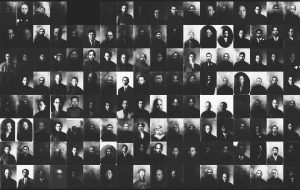
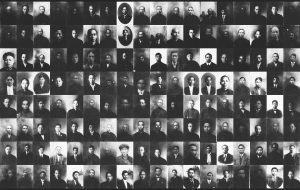
In asking for the collectivity of these 286 photographs to be seen together as a way to envision kinship, I am calling for a rethinking of the family album. In Suspended Conversations Martha Langford observes that “family has always begged explanation, and the ‘family album’ does too” (2001, 99). In this sense, I want to assume the role of the “compiler” of this family album and use the remainder of this chapter to offer what Langford calls “the oral scaffolding” (23) for the Oanfa album. I will point to pictures and tell you about the connections between them. “The album is an instrument of collective show and tell,” writes Langford (20); let us look at how these CI 9s function as a collective. Even though no one on this ship is pictured together in the album, there are relations between all of them that matter. These photographs of Chinese migrants aboard the Oanfa depart from the way in which families have been represented but I argue that they are, taken together, a portrait of kinship forged out of the diasporic experience of a passage and the histories of racism that bound them through this process of mass capture.
Regarding the photographs from these 286 CI 9 certificates as a kind of collective family portrait is one way to decolonize family photographs in the manner outlined by Andrea Doucet. In her discussion of decolonizing family photographs, Doucet argues for taking up “non-representational” approaches where “a shift to nonrepresentation means thinking about the dialogic and performative character of narratives and how they are made and remade within relational webs and relational ontologies” (2018, 19). Decolonizing the family photograph is grounded in the shift from knowing by looking at something to knowing through the intimacies of engaging with the images’ materiality. For mass capture, this material is not necessarily about physically handling the photographs themselves – an act which is, as the coda to this book will discuss, nearly impossible – but rather about materiality in terms of the conditions of the object’s production. For the CI 9s, this materiality is about taking into account the persecution that has led to the production of these photographs on these forms.
Considered as a whole, the 286 photographs of CI 9 holders on the Oanfa is a collective portrait emerging out of persecution. Seeing these photographs as tied to one to another, we can break down the ways in which these men, women, and children were visually siloed. We can see through the persecution of their isolation. Kept apart from one another, denied the intimacy of being pictured together, these are images of mass capture as a denial of kinship. Viewing them together is itself a radical act of picturing what mass capture could not fully do. The people on this ship did have relationships; they were bound by feelings of kinship, of ship brotherhood and sisterhood. We have to look for these intimacies despite the conditions of their persecution. For McAllister, persecution means “actions taken against a group that restricts or denies their freedom to participate in society and maintain and develop their identities, cultures, and political institutions. The ability to record, save, and transmit information about their lives is impeded through laws such as censorship, destruction, or confiscation of their records, poor institutional funding, public hostility, and hate crimes: recall the Black Loyalist Heritage Centre in Birchtow, which was burnt down in 2006” (2018, 169n2). McAllister’s definition points to the role of private and public records in the persecution of a community. The CI 9 records persist despite the families that were ruptured by the laws of which the CI 9 system is a part. In seeing the Oanfa photographs collectively, we counter some of the state’s attempts to deny these migrants a sense of kinship. In her examination of Japanese-Canadian family photographs, Namiko Kunimoto argues that family photographs taken under conditions of persecution “allowed a space of intimacy between the image and the subject, a space denied in political propaganda and the official documentary photographs of Japanese Canadians … Photographs by government officials most often represent Japanese internees as an anonymous, powerless group – a problematic representation that personal photography works against” (2004, 142). While the CI 9 photographs were not directly produced by the state, their use by the state effected a refusal of feelings of kinship that viewing them collectively restores.
This restoration through envisioning kinship across the forms and regulations that divide does ask the viewer to look at the idea of kinship and family non-representationally. It asks for a way to see family by shifting what a representation of a family should look like. But this shift poses a different kind of ethical question, one that Doucet draws from Cate Sandilands: “‘How can the recognition of the limits of representation coexist with the desire to include – represent – other voices more fully?’” (2018, 19). In response to this question, I ask for the inclusion of this shipboard brotherhood and sisterhood to be understood as a representation of family photography. To find family in the wake of the devastation of legislative practices that deliberately sought to separate families from each other means looking for representations that are non-representative. Following Gillian Rose (2010), Doucet notes that “social, public, and cultural narratives of family photos have widened to include how particular kinds of ‘family photographs are entering public circulation’ and ‘public spaces of display,’ thus changing the conceptual meanings of both family photographs and intimacies” (2018, 19). While Rose and Doucet discuss contemporary family photography, their embrace of the need to change what we think of as family photography, and of the intimacies in those images, resonates with my call to think of the Oanfa photographs as a collective portrait, and as an envisioning of the feeling of kinship.
Looking at identification photographs in aggregate, as a collective portrait spanning the berths of single ship, also allows for a different understanding of the relationship between these photographs and vernacular photography. Like conventional family photographs, identification photographs are part of a genre of photography known as “vernacular photographs.” Geoffrey Batchen writes of vernacular photographs as “tending to be made in vast numbers by anonymous, amateur, working-class, and sometimes even collective hands or, worse, by crass commercial profiteers … they muck up the story of great masters and transcendent aesthetic achievements, and disrupt its smooth European-American prejudice” (2002, 57–8). Annette Kuhn applies this idea to family photographs in particular when she argues for the critical value of these images: “As commonplace material artifacts, family photographs and albums contain meanings, and also seem infinitely capable of generating new ones at the point at which photography and memory work meet” (2007, 285). Expanding the idea of the family photograph or family album to a collection of 286 identification photographs of migrants aboard a ship reveals the necessity of memory work for looking at these photographs. Engaging with them non-representationally, as Doucet advises, allows a view into intimacy and feelings of kinship that would otherwise be invisible. Adopting a “nonrepresentational approach to family photographs … attends to images as a set of practices whose content and meanings are in turn made within social practices, including specific research practices wherein the photos are viewed and discussed” (Doucet 2018, 11). Examining the CI 9 photographs as part of a practice addresses the ways in which families are not obviously represented in these images and allows for a way of envisioning kinship non-representationally. While identification photographs and family photographs might both easily fall under the concept of the vernacular photography, they are not often thought of together. Doing so now, thinking of identification as a route to kinship, is one way to see through the persecution of mass capture.
Even though the CI 9 archive is overwhelmingly one of people separated from their families, it is also a site for understanding how the relationships formed on board a ship offer a view of relation grounded in the experience of diaspora. These migrants are bound by the experience of the passage “home.” Though the CI 9s are visual representations of social isolation and the systematic rupture of families, the Oanfa portraits collectively outline the twofold nature – destruction but also formation – of mass capture’s effect on kinship and relation.
Rupture, Relation, and the Lawson Family on the Oanfa
Head tax and exclusion legislation systematically denied thousands of families the opportunity to be together, but there are some conventional families that can be found in this archive. The Lawsons were one such family and they happened to have been aboard the Oanfa. However, as I will show, even conventional families – where such families are defined as configured by a father, mother, and children – must be envisioned outside the conventions of both family and family photography.
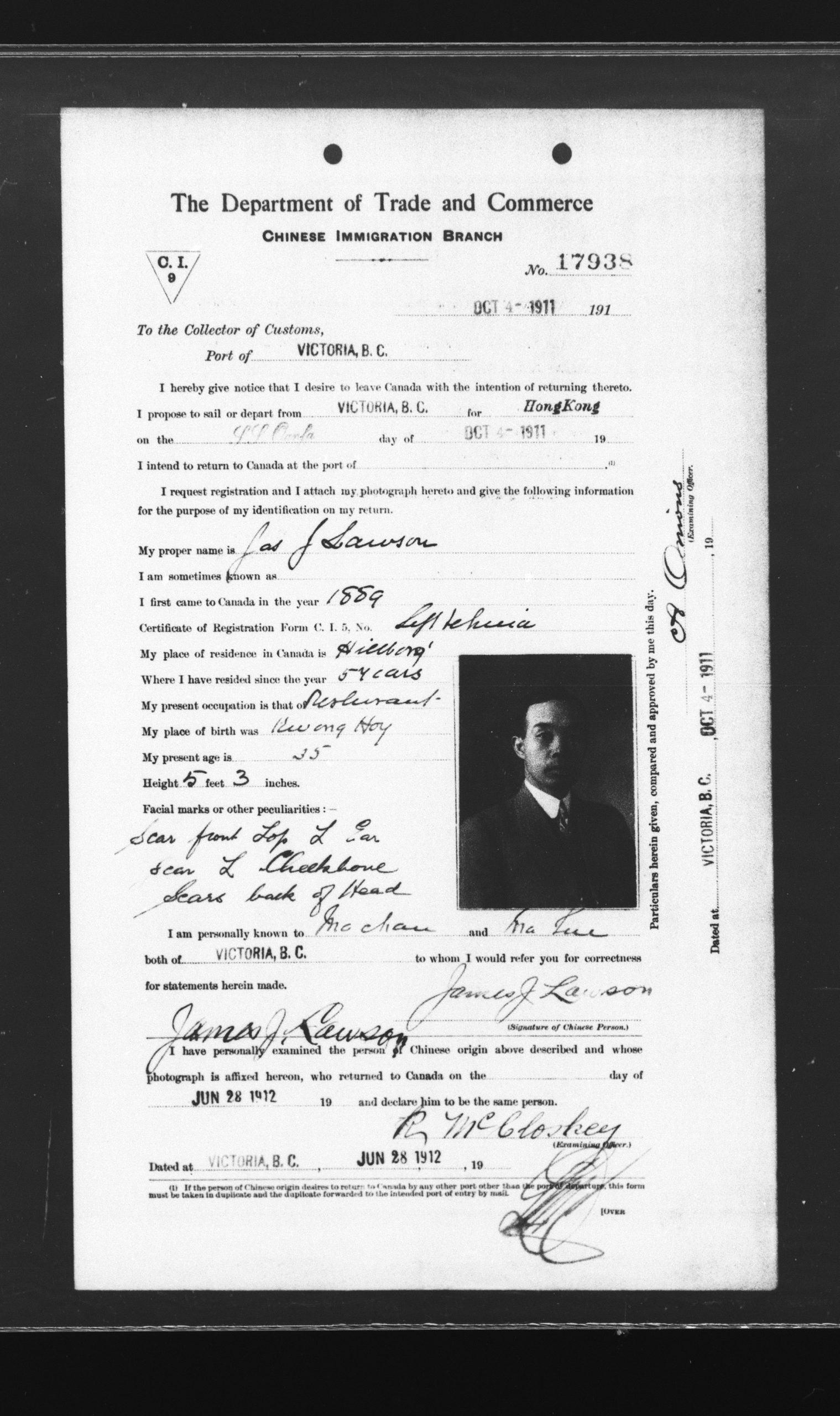
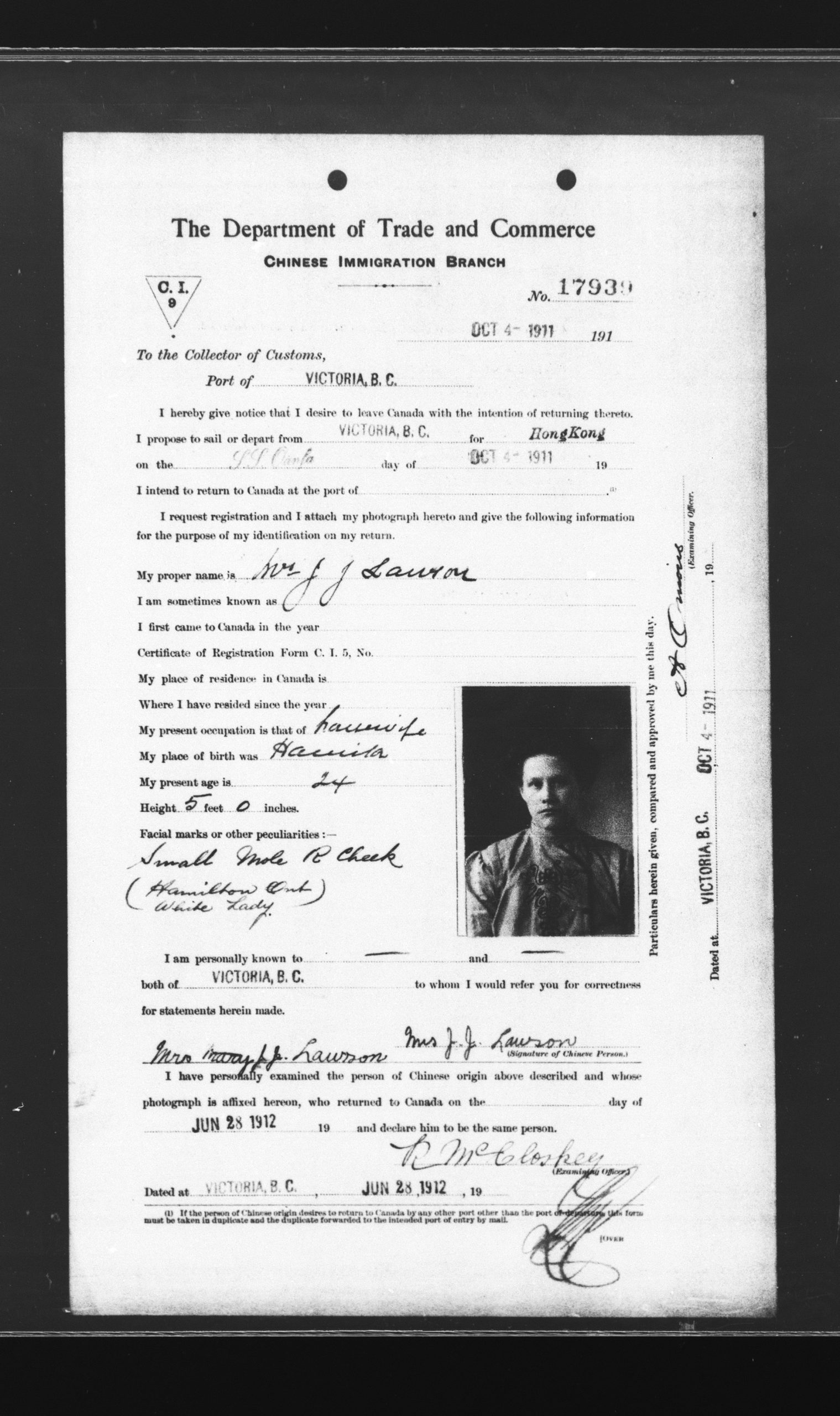
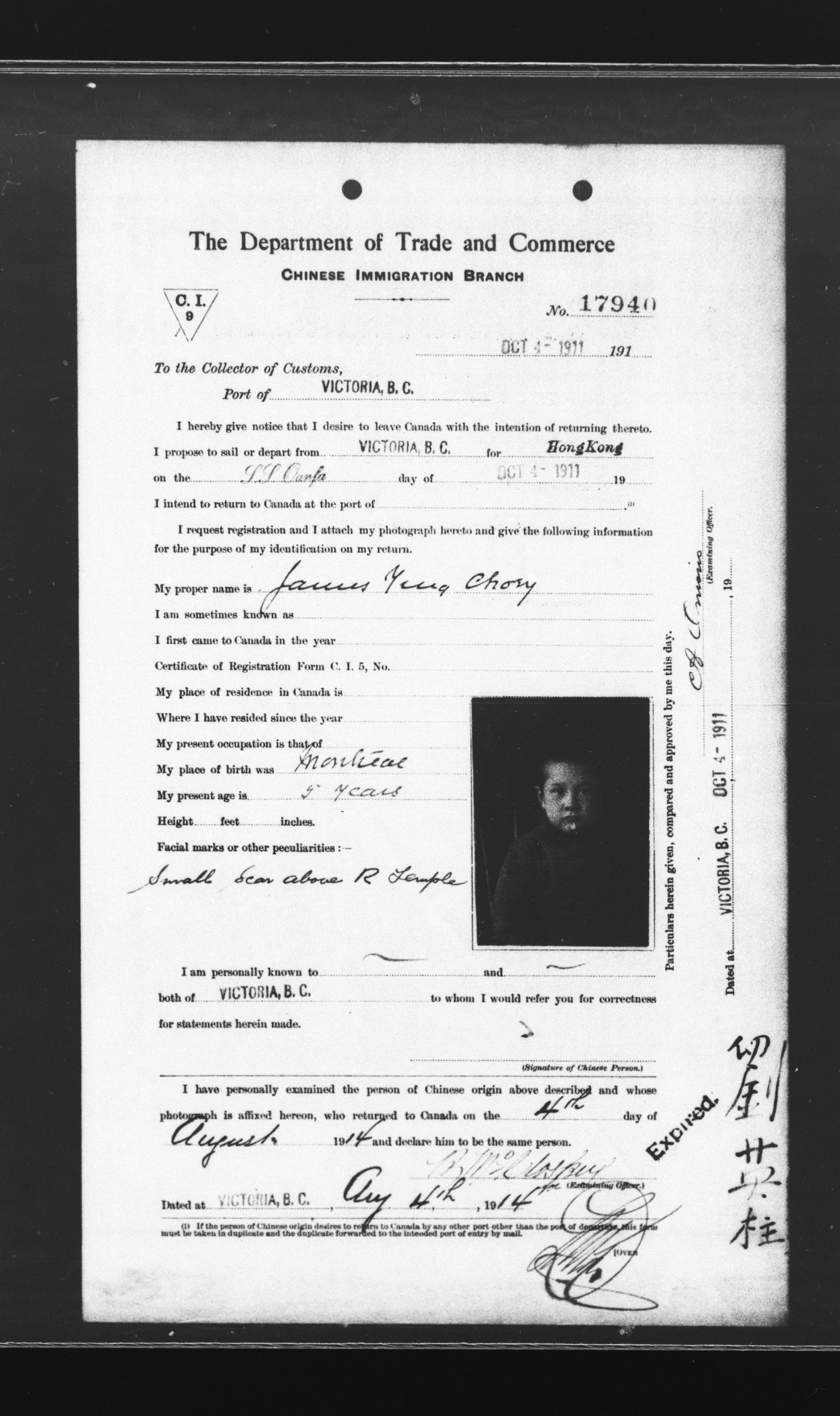
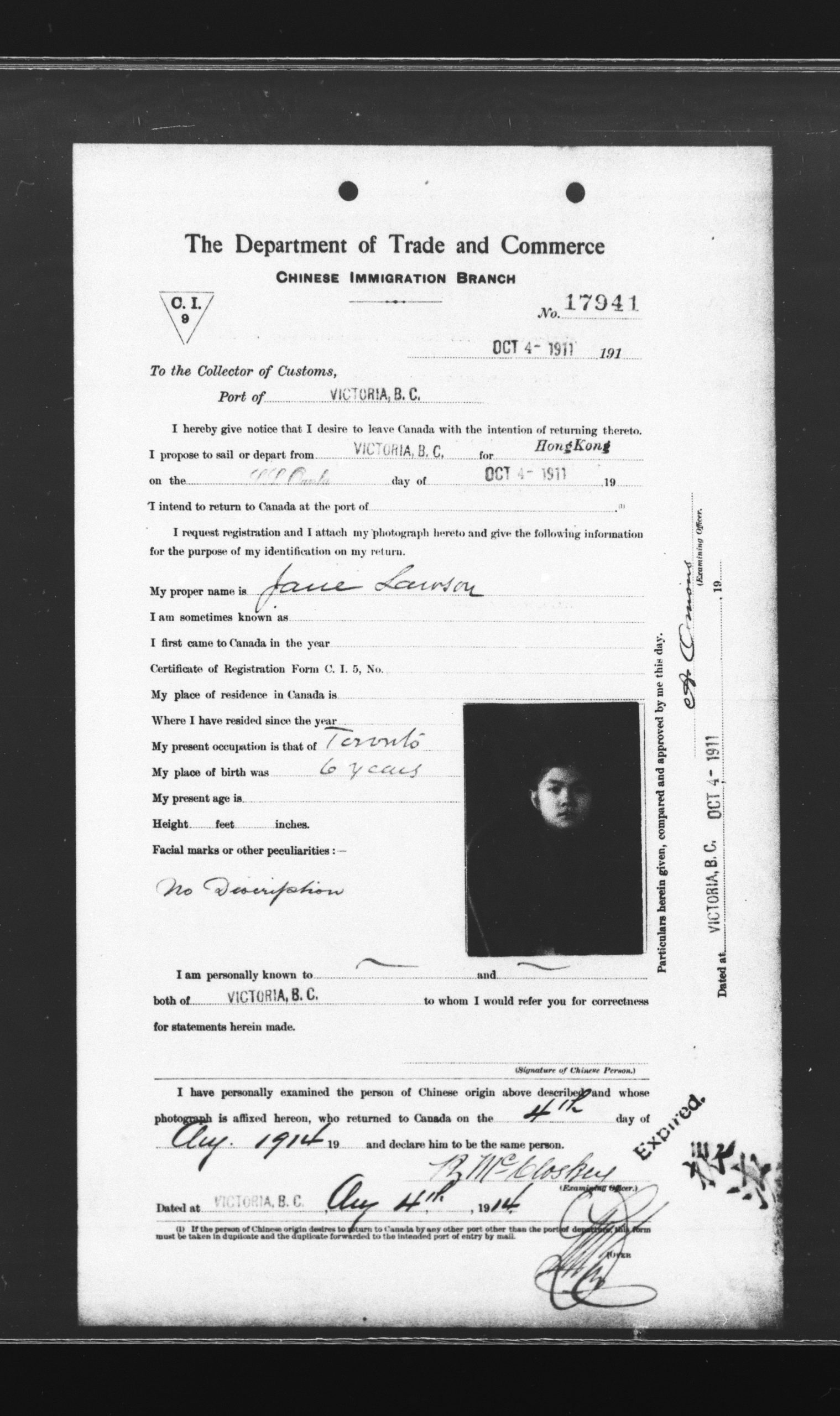
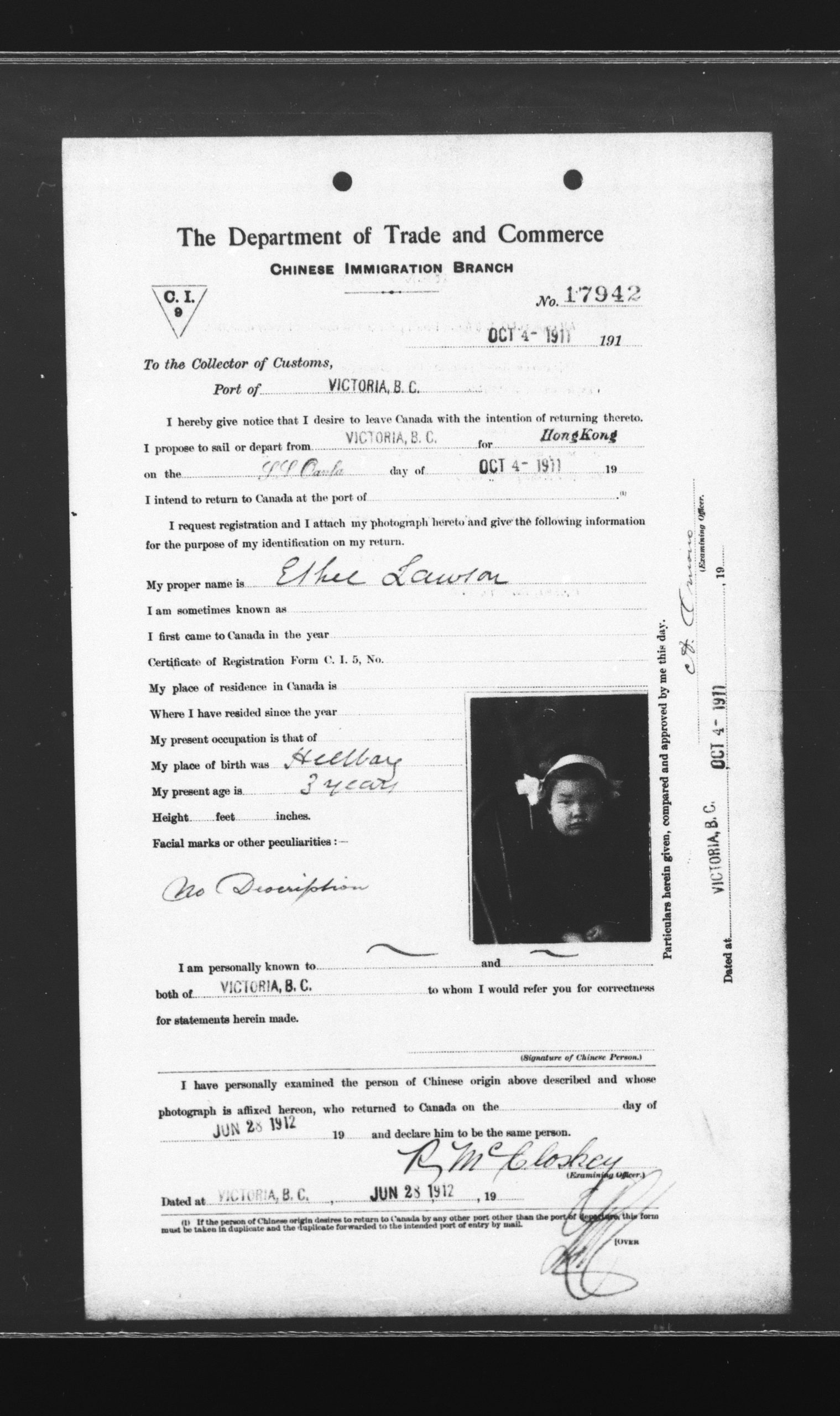
Tucked in the midst of the CI 9 certificates of passengers on the SS Oanfa in 1911, you will find a family portrait that may not, at first, look like a family portrait (figs. 3.18–3.22). Here, in numerical sequence and as identified by the names written on their certificates, are: James J. Lawson, aged thirty-four, CI 9 no. 17938; Mrs J.J. Lawson, aged twenty-four, CI 9 no. 17939; James Ying Choury, aged five, CI 9 no. 17940; Jane Lawson, aged six, CI 9 no. 17941; and Ethel Lawson, aged three, CI 9 no. 17942.
Unlike the Chong family discussed earlier in this chapter, the members of this family are not pictured together. Indeed, it is not immediately obvious that they are a family at all. On the basis of the information on the certificate alone, James Ying Choury would not seem to be a member of the Lawson family. Jane and Ethel share a surname with James J. Lawson and Mrs Lawson. There is much to say about Mrs Lawson, but let me first unfold the relationships between the members of the family pictured here. From the deployment of the honorific “Mrs,” and her proximity to James J. Lawson in the sequencing of the certificates, it seems almost certain that Mr and Mrs Lawson are married to each other. The surname also offers a strong indication that Jane and Ethel are the children of Mr and Mrs James J. Lawson. Again, unlike the Chongs, the Lawson children are not afforded the privilege of being identified in terms of their familial relation to each other. There are no scripts pointing to them as sisters or daughters. Without more information (and there is more, but not here), we can only guess that the two Lawson girls are the daughters of Mr and Mrs Lawson. But what to do with the fact that each Lawson is identified with a different geographic location? Mr Lawson’s place of residence appears to be “Hillborg”? Mrs Lawson is not given a place of residence and is identified geographically only by place of birth: Hamilton. On Jane’s certificate, there is only “Toronto” written next to the line for “present occupation.” Presuming that Toronto is not an occupation and that the agent meant to write this on a different line, Toronto could either be her place of birth or her place of residence. On Ethel’s certificate, a place that looks like “Hellbay” is listed as her place of residence. Four people, seemingly travelling together and sharing one surname, but not one clearly identifiable place of residence among them.
And what to do with five-year-old James Ying Choury, who does not share a surname and seems to have no place of residence but only a place of birth, “Montreal”? I will return to James.
First, let me sort through the relationship between Mr and Mrs Lawson, and Jane and Ethel. In order to find this relationship, we have to go outside of the CI 9 archive and into birth and marriage records. According to the record of Jane Lawson’s birth shown in figure 3.23, she is indeed the daughter of James J. Lawson, as listed on line 44. From this record, we now also have Mrs Lawson’s maiden name: “Mary C. Fuller.” This information can be further corroborated by Jane Lawson’s marriage certificate (fig. 3.24), from which we learn that she was born in Toronto, that her mother’s full name is “Mary Catherine Fuller,” and that Mrs James J. Lawson (née Mary Catherine Fuller) was born in Hamilton, Ontario.
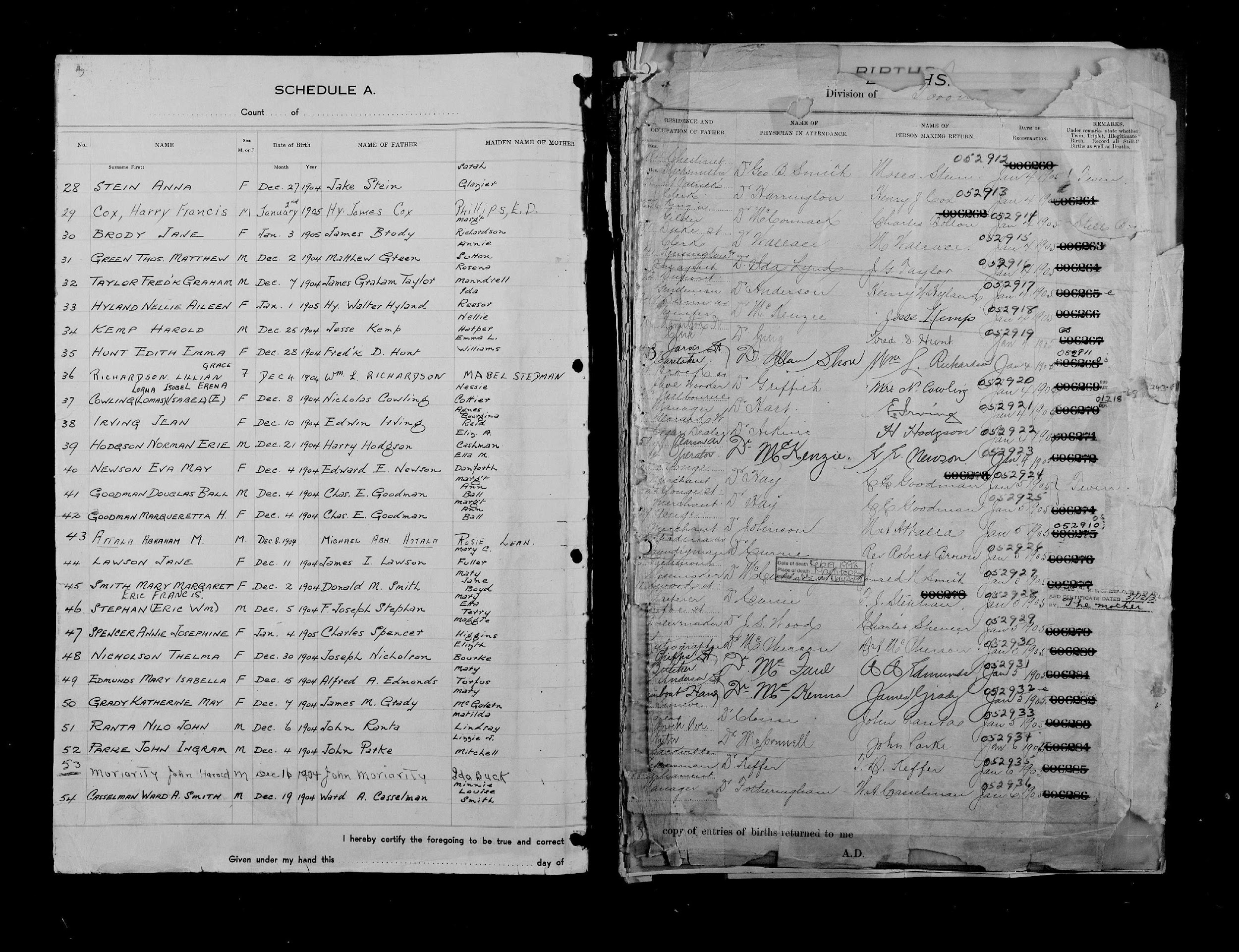
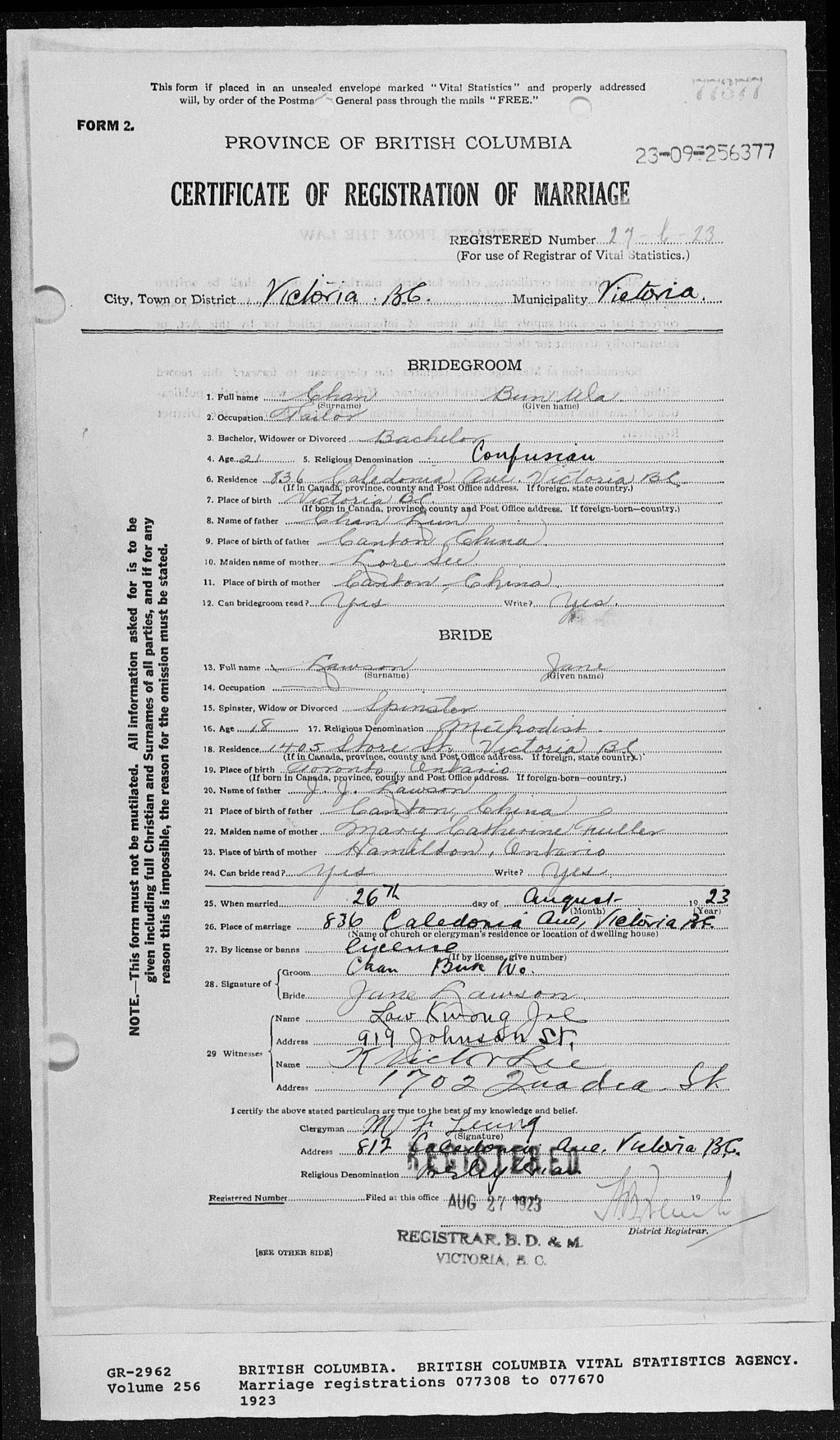
Ethel Lawson’s birth certificate uncovers the mystery behind the terrible handwriting that obscures her place of residence and that of her father: not Hellbay or Hillborg but Haileybury, Ontario (fig. 3.25).
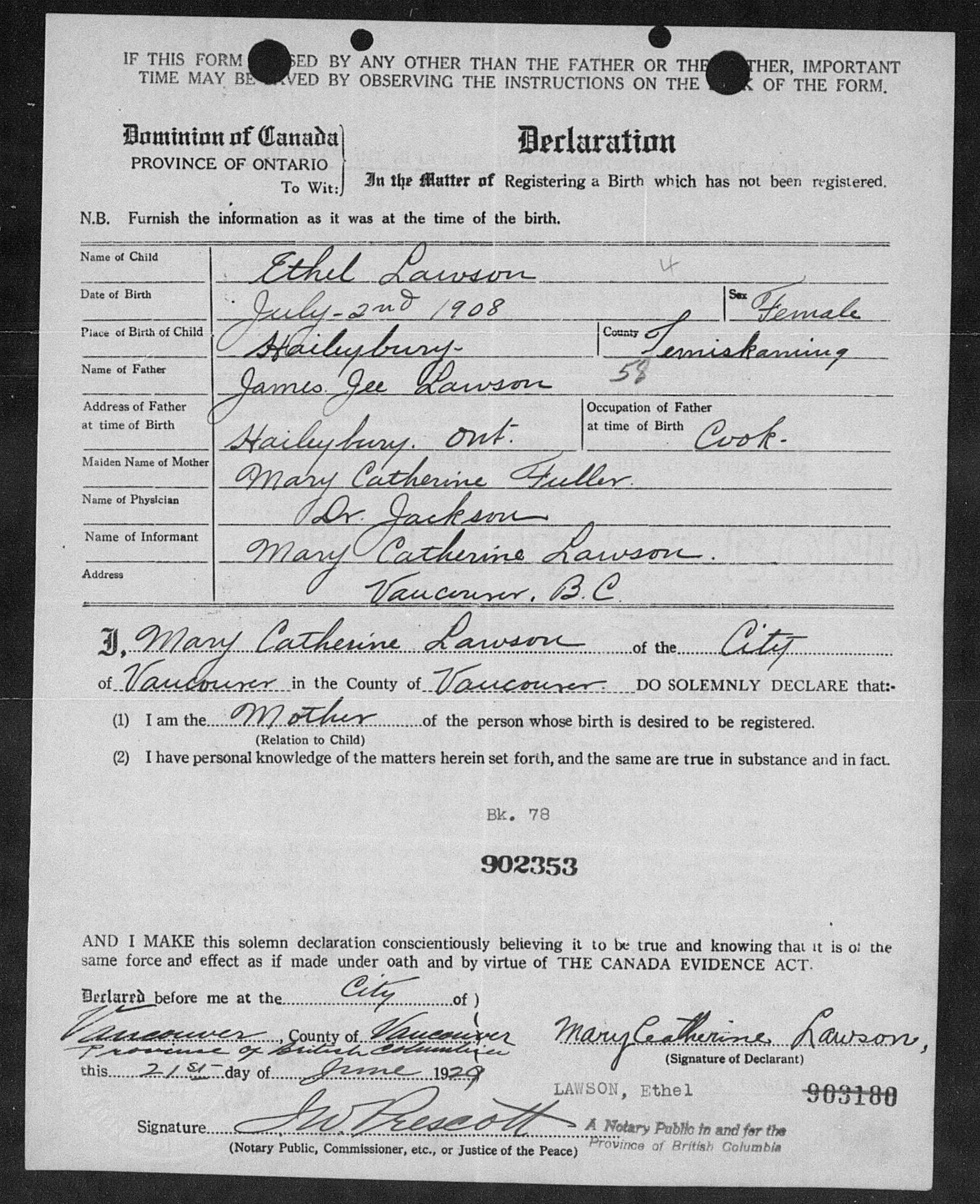
Now, James Ying Choury. As a five-year-old, he could not have been travelling unaccompanied. The numerical sequencing of his CI 9 suggests that he travelled with the Lawsons. But nothing about his name, nor his unlisted place of residence, nor his listed place of birth (Montreal) connects him to the Lawsons, who, we now know, resided in the town of Haileybury where James J. Lawson worked as a cook and where Ethel was born, and who were also connected to Hamilton, where Mrs James J. Lawson (née Mary Catherine Fuller) and Jane were born. However, James Ying Choury’s record of death shows that his father was indeed James J. Lawson (fig. 3.26).
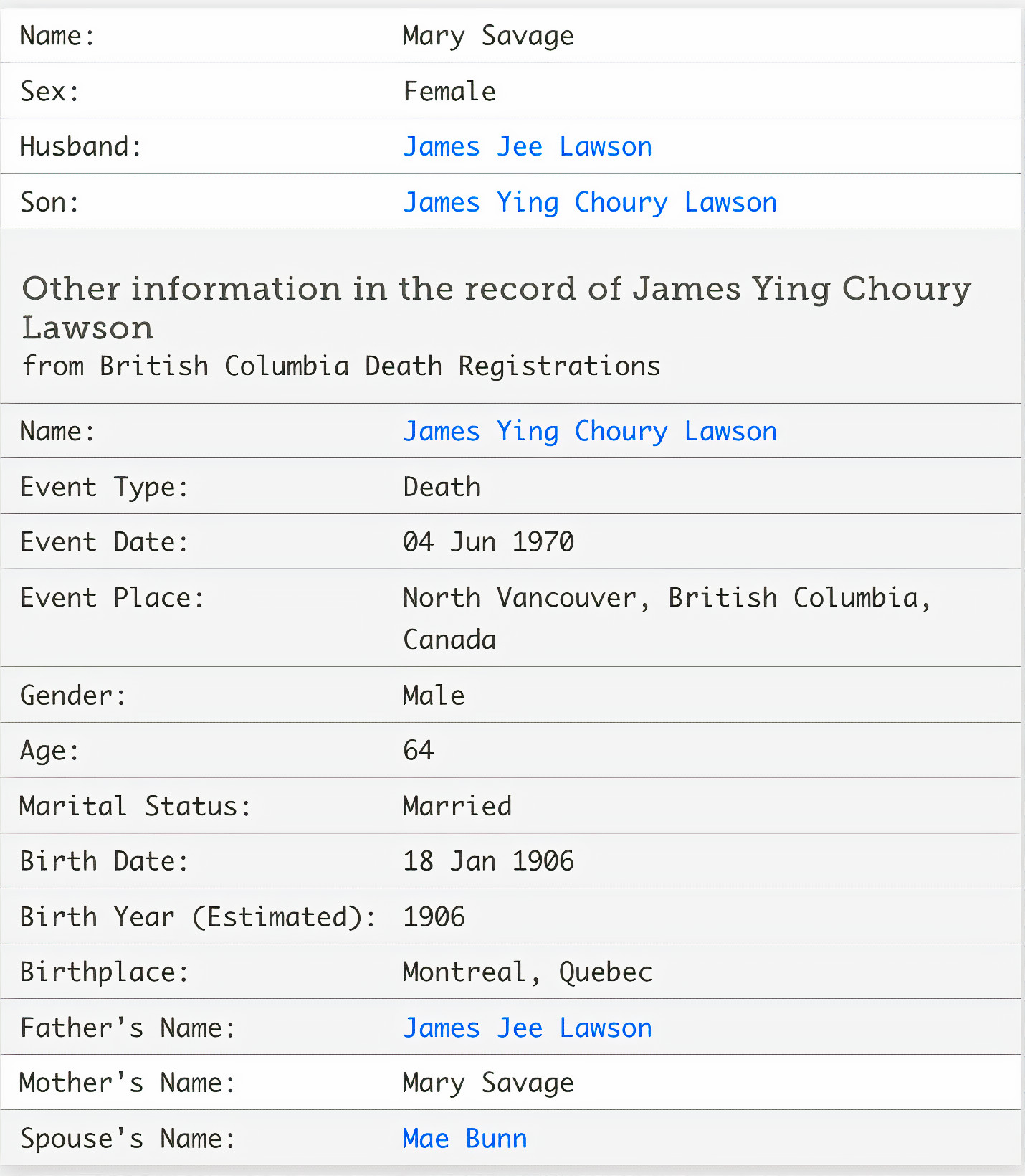
In this record James Ying Choury is given the Lawson surname, and here, we also learn the name of his mother, “Mary Savage.” Was James a half-brother to Ethel and Jane? No. We have to look even further to find the truth of his familial relationship. Mary Savage’s obituary in the 25 January 1950 edition of the Vancouver Sun reads in full:
SAVAGE – Passed away suddenly Jan. 23, Mary Catherine (nee Fuller), beloved wife of John Savage, 407 Nelson St., in her 62nd year. Survived also by 6 daughters, Mrs. Jan Chan, Mrs. Victoria Long, Mrs. Edna Savage Chew, Mrs. Beth Malbeuf of Vancouver, Mrs. Ethel Jayne of Philadelphia, Mrs. Pearl Fletcher and 1 son, Mrs. James Lawson of New York; also 28 grandchildren and 3 great-grandchildren. Funeral service, Thursday, Jan. 26, at 1:30pm., from Armstrong & Co., Chapel of Flowers, 304 Dunleavy Ave., Rev. H. R. Whitehead officiating. Internment, Forest Lawn Memorial park.
Now we know that Mary Catherine Savage was also Mary Catherine Fuller, and that James Ying Choury is her son and brother to Ethel and Jane. By the time she died, she had remarried and John Savage was her husband. But the CI 9 certificates for this family do not make any of these relationships clear. Looking only at CI 9 nos. 17938, 17939, 17940, 17941, and 17942, the relationships between the members of this family are obscure at best. There is more to say about the Lawson family and their journey on the Oanfa, but before I go on, I want to emphasize how the mass capture process itself has fractured this family. These certificates show how the Chinese Immigration Act, along with other forms of legislative and social discrimination, worked to isolate this family from each other and from the communities in which they lived. This family would have suffered particular pressure because Mary Fuller was not Chinese.
When Mary Fuller boarded the Oanfa, she did so at a time of moral panic over contact between white women and Chinese men in Canada. As Karen Drubinsky and Adam Givertz argue, there was a “campaign to construct Chinese men as sexual villains [that] involved the interaction of several historical processes, namely, the making and remaking of sexuality and the relatedness of gender, class, and race” where “the connection between these is illuminated in the fabrication of the Chinese man as simultaneously degraded labourer and a debaucher of young White girls” (2003, 72). White masculinity defined itself through this twinned process of degrading and sexualizing Chinese men: “the image of Chinese men entrapping White women was crucial to the formation of Anglo-Canadian male identity, and certainly also reinforced already existing concerns among White male labourers about economic competition” (ibid.). This consolidation of Anglo-Canadian masculinity culminates in a series of what are known as “White Women’s Labour Laws” enacted across Canada. While Saskatchewan led the way, passing An Act to Prevent Employment of Female Labour in Certain Capacities in 1912, British Columbia, Manitoba, and Ontario followed suit over the next seven years modelling their statutes on Saskatchewan’s (Backhouse 2004, 346).
These statutes were explicitly racist in their targeting of Asian men. For example, the Saskatchewan statute reads, “No person shall employ in any capacity any white woman or girl or permit any white woman or girl to reside or lodge in or to work in or, save as a bona fide customer in a public apartment thereof only, to frequent any restaurant, laundry or other place of business or amusement owned, kept or managed by any Japanese, Chinaman or Oriental person” (quoted in Backhouse 1994, 136). This law also inaugurates whiteness as a legal concept in Canada: “While the property of ‘whiteness’ was clearly a definable asset from which all manner of privilege and power flowed, it tended to disappear in legal terminology. The ‘white women’s labour bill’ marks the first overt racialization of ‘whiteness’ in Canadian law” (Backhouse 2004, 360). In codifying whiteness this way, these laws show some of the ways whiteness defines itself through its engagement with Asianness.
While the racist impulse of these laws is undeniable, a careful examination of the enactment and enforcement (or lack thereof) of this legislation illuminates a much more complex picture of the relationship of whiteness to Chineseness. Interestingly, Ontario’s version of this statute “never received royal assent but remained amidst the statutes of [1914] as an unproclaimed bill. But when Ontario’s statute law was collected and rationalized in 1927 in a single bill, the Revised Statutes of Ontario, the unproclaimed bill, because of a technical error, became law” (Drubinsky and Givertz 2003, 249n46). The law did not go unchallenged. The Chinese consul general wrote, in September 1928, to W.H. Price, the attorney general of Ontario, to protest the law, and “a group of 69 [white] waitresses petitioned the Lieutenant-Governor of Ontario requesting that he rescind the legislation, stating that they were well satisfied with their employment. Ultimately, the act was amended under the Statute Law Amendment Act [1929] to return it to its unproclaimed state” (ibid.). The Statute Law Amendment Act (1929) was passed to read:
Section 30 of The Factory, Shop and Office Building Act is repealed and the following substituted therefor:
30. (1) No Chinese person shall employ in any capacity
or have under his direction or control any female
white person in any factory, restaurant or laundry.
(2) Subsection 1 shall not come into force until a day
to be named by the Lieutenant-Governor by his
Proclamation.
The date for the proclamation was never named, so Ontario’s prohibition of the employment of white women by Chinese men was left in a kind of legal purgatory, passed by the legislature but not in force. This move allowed the government to placate those who demanded that it take action to prevent the mixing of white women and Chinese men, while at the same time ensuring that the law itself was impotent. The moral panic may have been widespread, but its manifestation in the form of labour laws was not something that the government of Ontario actually had a genuine desire to enforce. That the province bothered to amend the accidental proclamation of the law in 1928 through a separate piece of legislation strongly suggests that the state had little appetite for this law as a law.
Despite the racism impelling the moral panic of this period, the passing but unproclaiming of Ontario’s laws about white women’s interactions with Chinese men gives some indication of the complexities attendant upon Mary Fuller’s relationship with James Jee Lawson. Indeed, the law was unproclaimed not once, but twice. That it was never made enforceable, that the government of Ontario went to the length of amending the statute in 1929 to undo the accidental proclamation of this law in 1928, suggests that the moral panic was not so widespread. The laws’ contorted history shows that Mary’s marriage to James, while not typical, was perhaps not wholly reviled; despite antagonism, there may have been more space for their relationship in Ontario rather than Saskatchewan or Manitoba. I have discussed these laws at some length because they are the clearest laws where the relations between white women and Chinese men were governed by legislation, which speaks to the social atmosphere. Of course, it is not necessarily the case that these laws, unenforceable though they were, necessarily applied to Lawsons. Although James J. Lawson identifies as working in a restaurant on his CI 9, and gives his occupation as “cook” on Ethel’s birth certificate (fig. 3.25), it is not obvious that Mary Fuller ever worked in the restaurants – or, even if she did, that she worked where James cooked. But let me return to the CI 9s themselves.
Separated from each other by the diplomatics of the CI 9 certificate where no one member of the family could name their relationship with another member of the family, James, Mary, James Jr, Jane, and Ethel are isolated from each other. They are scattered across geographies with each member of the family identified with a different town or city. Even when they are noted as living in the same place, as with the James J. Lawson and Ethel Lawson, the carelessness of the handwritten entries still makes it look as if they did not. Look again at James J. Lawson’s place of residence as compared to that of Ethel’s place of birth (figs. 3.27 and 3.28). It is only through further research in other archives that the scribbled locations on both certificates can be uncovered as “Haileybury.” And despite being able to place Ethel with her father there, the certificates still leave all the other members of the family strewn across multiple towns and cities. The geographical information pertaining to each member of the family on the form actually works against seeing these five people as members of a single family.


Two of the Lawsons, Mary Fuller and James Ying Choury, are particularly cleaved from their families in these CI 9s. The CI 9s deny them relation to the family of their birth. Let me discuss the case of the younger James first. The use of names works most cruelly against James Ying Choury. Why was he not permitted to also be known by the surname he shares with his father? It is only his certificate’s place in the sequence that hints that he travelled with the other Lawsons. Knowing his proper surname allows us to find him again in the CI 9 archive. A decade later, on 14 February 1921, he leaves from the Port of Vancouver. He has more scars. He signs his name in Chinese. This choice to write his Chinese name instead of his anglicized name is particularly notable given that his father, James Jee, never writes his name in Chinese. Indeed, we only know this family’s surname in Chinese, 劉 or Lau, because the younger James insists upon being known as such, at least in the moment of self-naming that is the signature on the form.
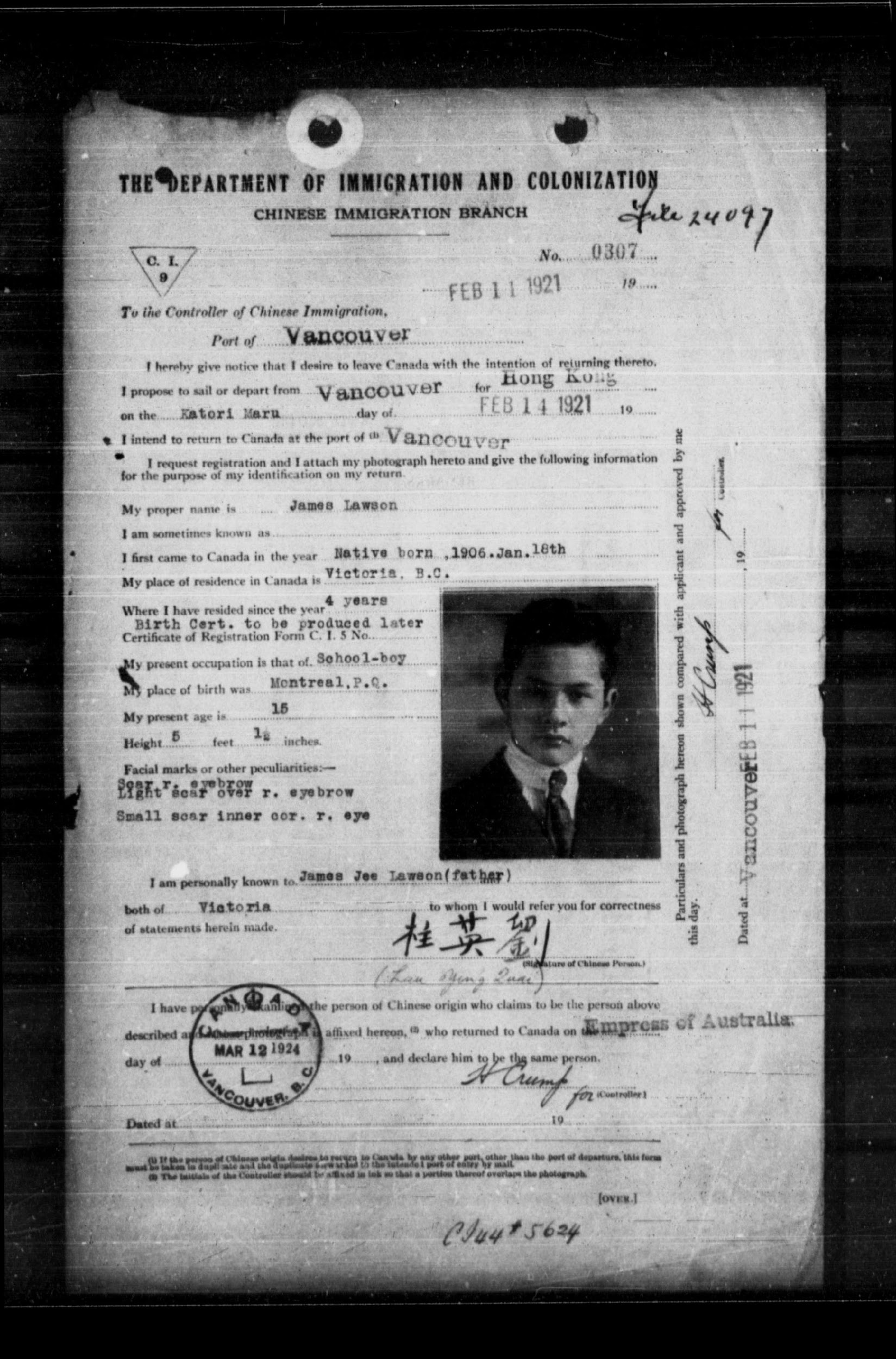
Knowing his surname, that he is not only James Ying Choury but also James Lawson, allows us to learn about the life he led. His obituary in the 15 June 1970 edition of the Vancouver Sun reveals that he was “a printer by trade, working as a compositor and proofreader for the Pacific Press,” and that he was a leader in the Boy Scout movement who received the “highest award given to Boy Scout organizers shortly before his death June 4.” He was married to Mae Bunn when he died, but had previously been married to Ann Chung. His wedding to Ann Chung in 1935 was reported in the Boston papers with the headline, “Chinese Bride and Bridegroom Married at Methodist Church.”
CI 9 no. 0307 opens up the life of James Y.C. Lawson. Here, at least, he is given and gives his proper surname, in Chinese and English. Here, his date and place of birth. Here, his place of residence from the years 1917–21. Here, at last, his father is clearly identified. But the CI 9s still leave the identity of his mother a mystery. Alone, without genealogical research, the CI 9s do not reveal his relationship to Mary Fuller.
Mrs Lawson, Mary Catherine Fuller, is torn from her family in a different way than her son. Married to James Jee Lawson, the CI 9 removes her from the family she had before this marriage. CI 9 no. 17939 reveals how a white woman would become Chinese in the eyes of the state. There are no laws that explicitly demand this transformation, but the effect of bureaucratic regulation effectively made her Chinese. Where other white people could travel in and out of Canada without a CI 9, without providing an identification photograph and having their identity documents filed for future suspicion upon their return to Canada, Mary Fuller, despite being a native-born Canadian from Hamilton, Ontario, was treated like any other working-class Chinese person. Even the privileges of her race did not earn her the right to be pictured with her family. Her Chinese affiliation is emphasized by the donning of explicitly non-Western clothes in her identification photograph. Indeed, her CI 9 is full of conflict in terms of racial identifications. Her place of birth is written twice on the form. Once it appears where it should, on the blank space next to the line reading, “My place of birth was.” Then, as if it needed to be underscored, it is written again in the space reserved for “Facial marks and other peculiarities.” In parentheses under the notation “small mole r cheek” are the words, “Hamilton, Ont,” and underneath that, “White Lady.” Her Hamilton roots and her whiteness are doubly emphasized. But her relationship to her husband, despite the fact that she is identified only by his name, is not. Thus, she is “Mrs JJ Lawson,” but there are only cursory dashes in the space where she could have been identified as having ties to her husband, or anyone at all. She is not “personally known” to anyone according to her CI 9, even though the agent could surely have written in this space that she is the wife of the migrant identified on CI 9 no. 17938.
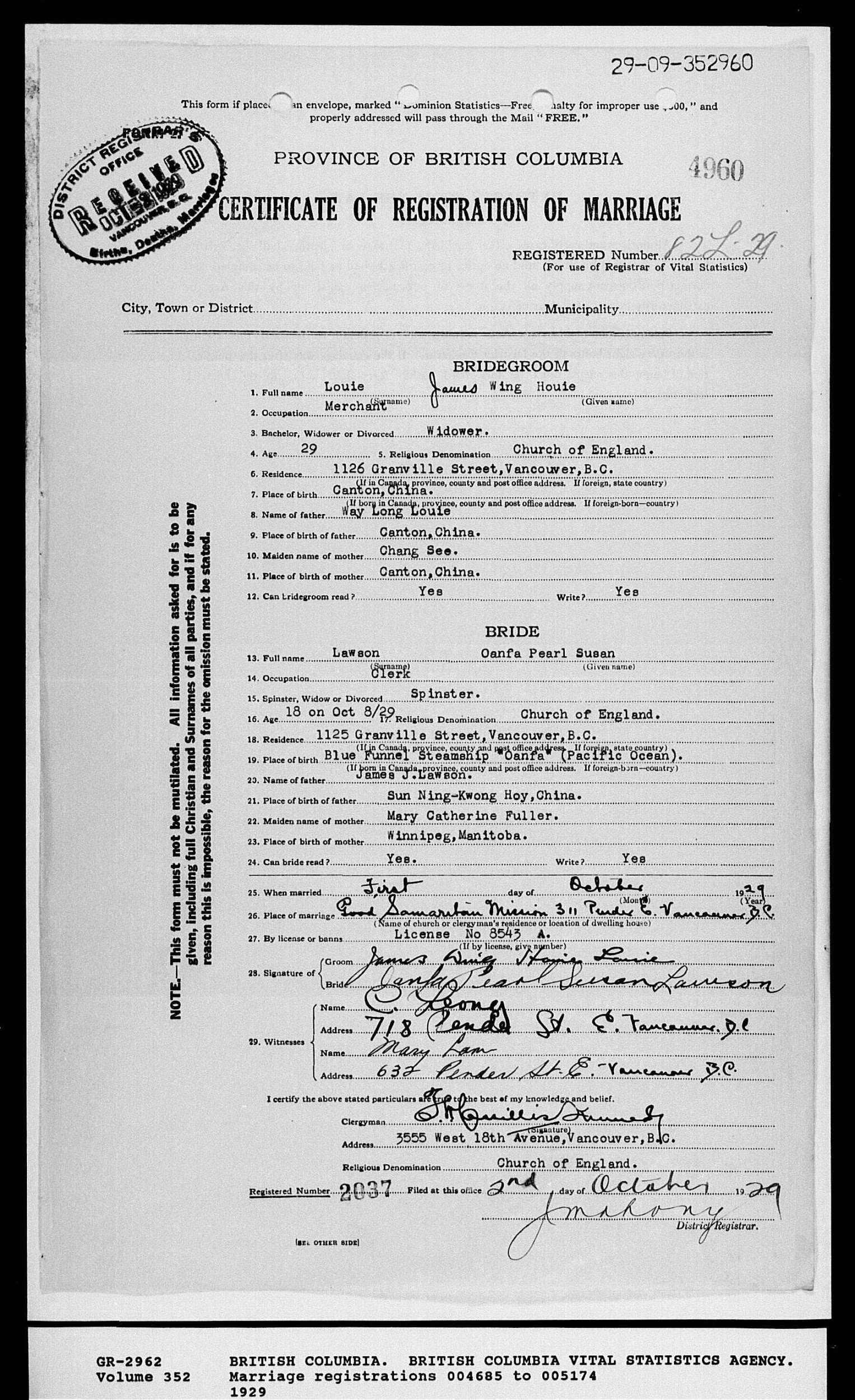
There is another family connection hidden in Mrs Lawson’s CI 9 of 1911. She is pregnant at the time this photograph was taken. She will give birth to Pearl Oanfa Susan Lawson aboard the Oanfa. Pearl’s marriage certificate reveals her unseen presence on Mrs Lawson’s 1911 photograph (fig. 3.30). Pearl’s place of birth is given as “Blue Funnel Steam ship ‘Oanfa’ (Pacific Ocean).” She is an eighteen-year-old “spinster” when she marries in 1929. On this certificate, her father is James J. Lawson and her mother is Mary Catherine Fuller. Pearl’s marriage certificate notes that her mother, Mary, was born in Winnipeg; Mary Fuller has, until now, been identified as being from Hamilton. But Mary had also been in Winnipeg. Indeed, a 1912 travel document notes that James Jee Lawson lived in Winnipeg for six years, beginning in 1896, and then moved to Haileybury. It seems likely that he met Mary in Winnipeg.
There are two more children of James Jee Lawson and Mary Fuller who are not pictured: Mamie Lawson and Victoria Lawson. According to the record of her death, Mamie lived for less than six months (fig. 3.31). This record shows that she was born to James Lawson and Mary Fuller in Haileybury, on 24 March 1910. She died on 14 September 1910. Less than a year later, in October 1911, James and Mary will have gathered up their remaining children, Ethel, Jane, and James Jr, and sailed for Hong Kong on the Oanfa. Pearl Oanfa Susan would be born aboard this ship.
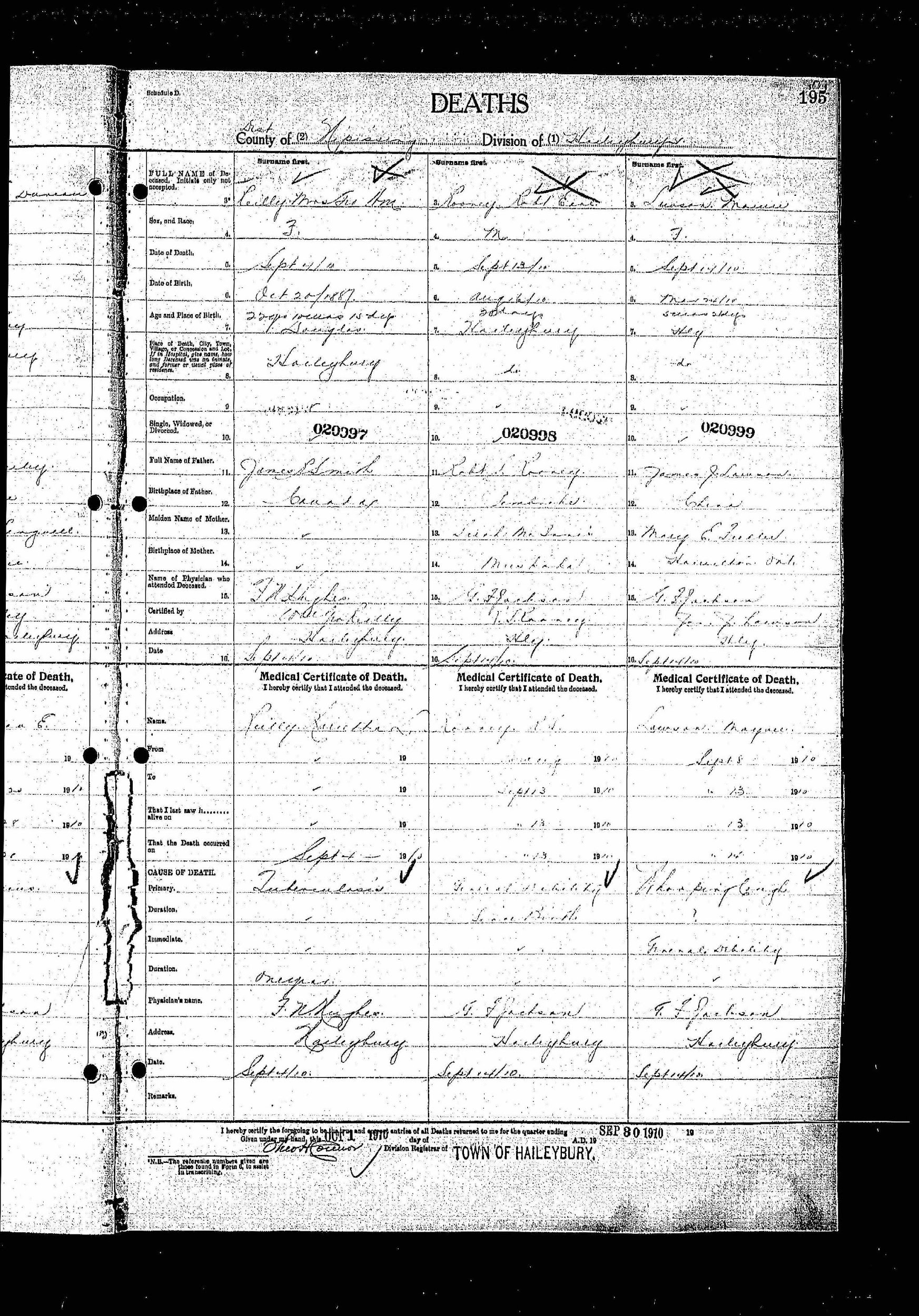
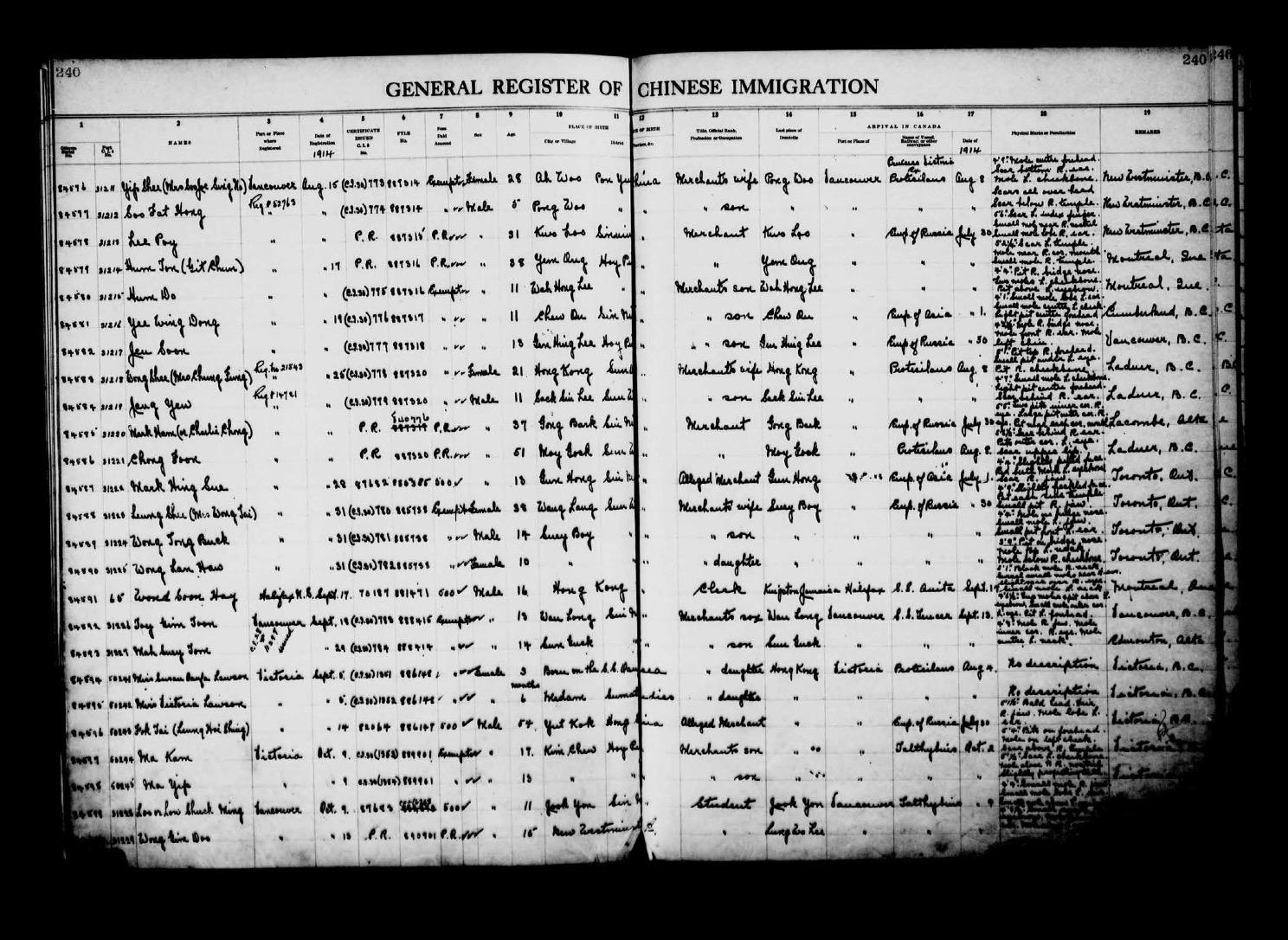
Victoria is registered with Pearl Oanfa Susan when they return to Canada with Mary Fuller and James Lawson on the SS Protesilaus on 4 August 1914. The girls’ entry into Canada is recorded in the 5 September 1914 General Register of Chinese Immigration (fig. 3.32). Pearl is three years old when she arrives in Canada. Victoria is six months old. The register confirms again that Pearl was born at sea on the SS Oanfa and that Victoria was born in Medan-Deli, Sumatra. Medan-Deli was a trading centre for tobacco developed by Dutch trading companies in partnership with the Sultanate of Deli. There were thousands of Chinese migrants living and working there at the time and it is notable that, in this General Register notation, Victoria and Pearl are each recorded as being a “Merchant’s daughter.” Since leaving Canada in 1911, James Jee Lawson has risen from being a cook to a merchant. Neither Victoria nor Pearl have CI 9s. They were born abroad and had not been in Canada before. Mary Fuller’s CI 9 shows that she returned on the same date as Pearl and Victoria, 4 August 1914 (fig. 3.33).
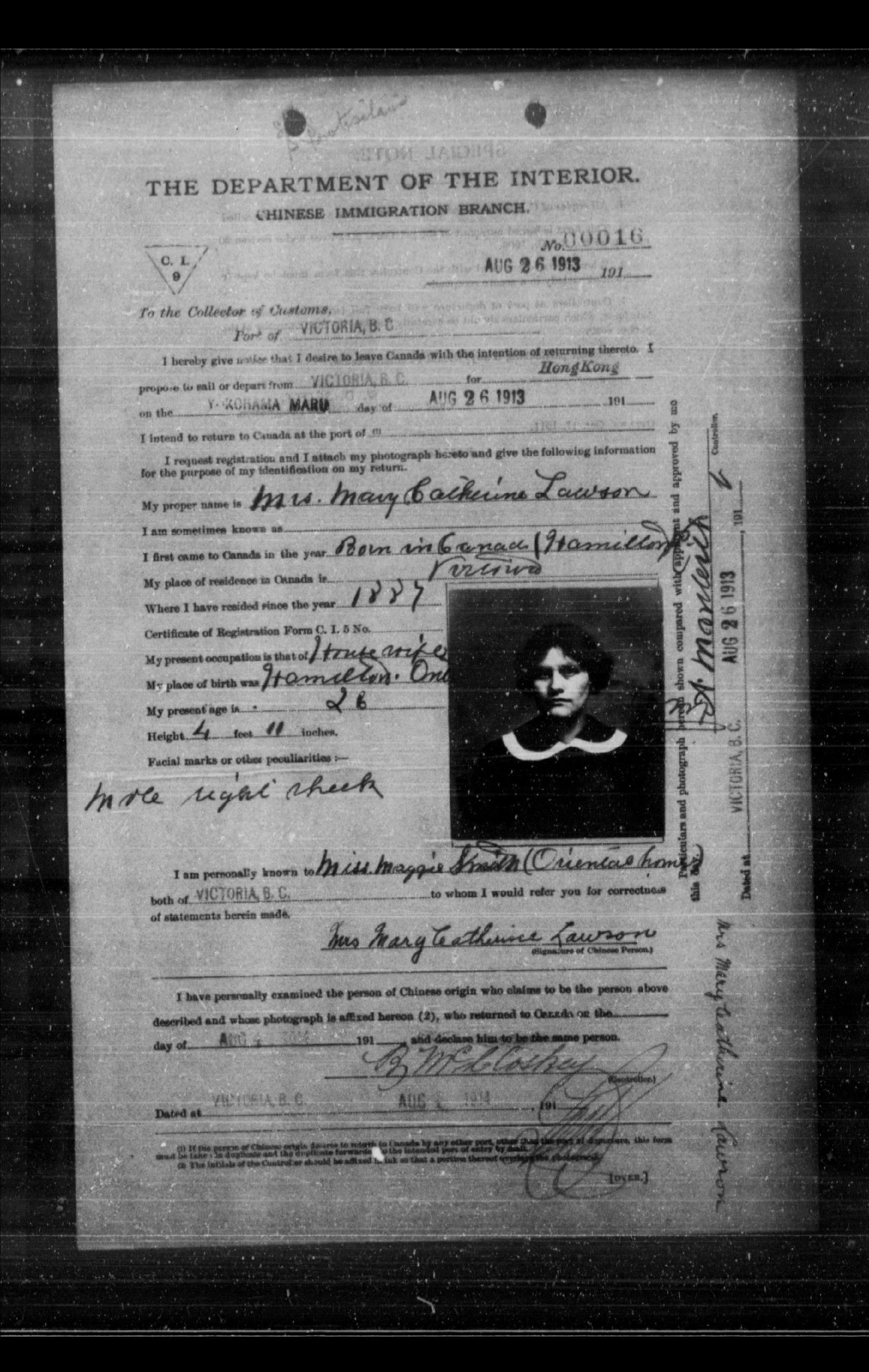
This CI 9 shows Mary having departed from Victoria on 26 August 1913. She sailed with James and Ethel. James’s CI 9 for the same departure is pictured in figure 3.34, and Ethel’s CI 9, travelling with her parents, is pictured in figure 3.35.
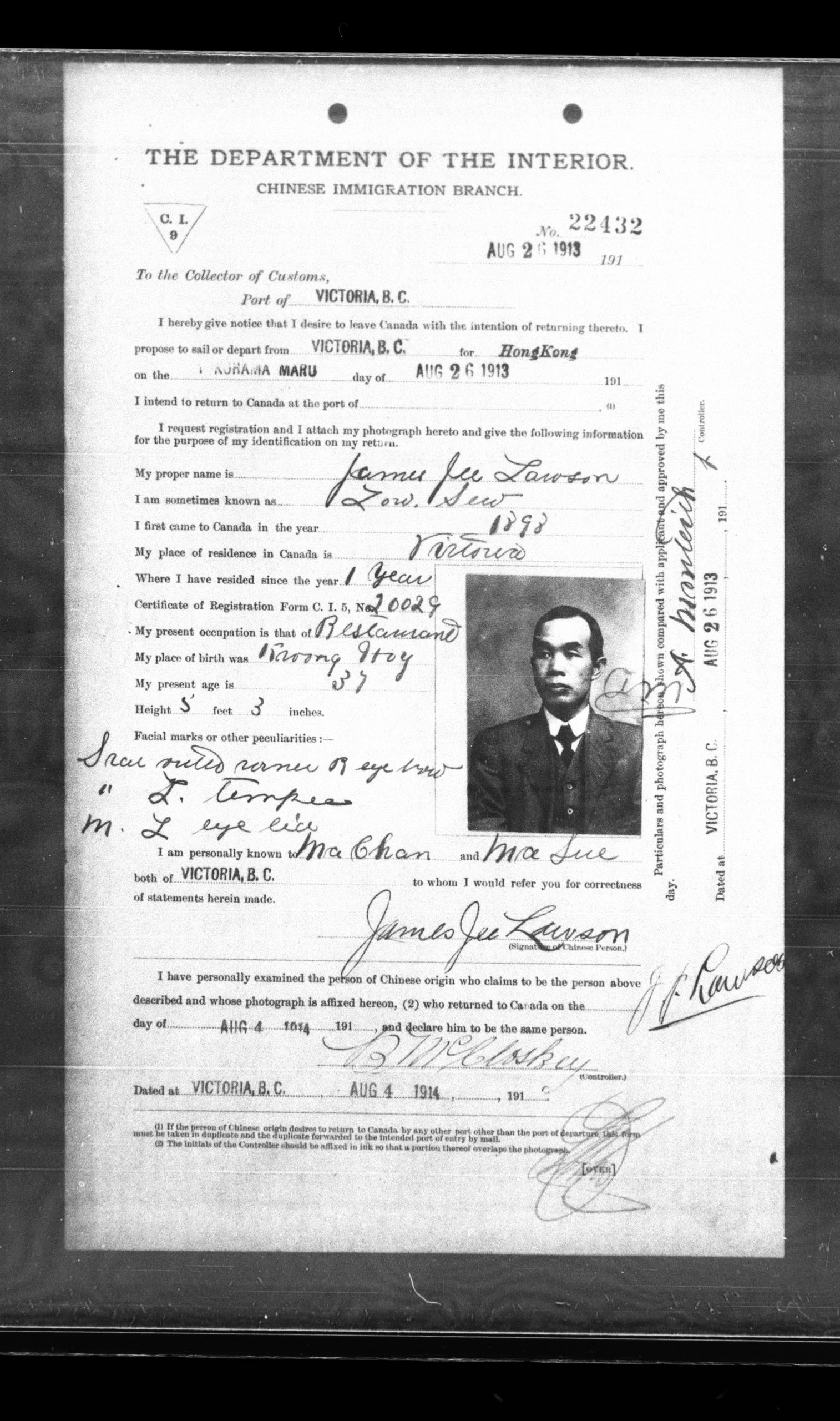
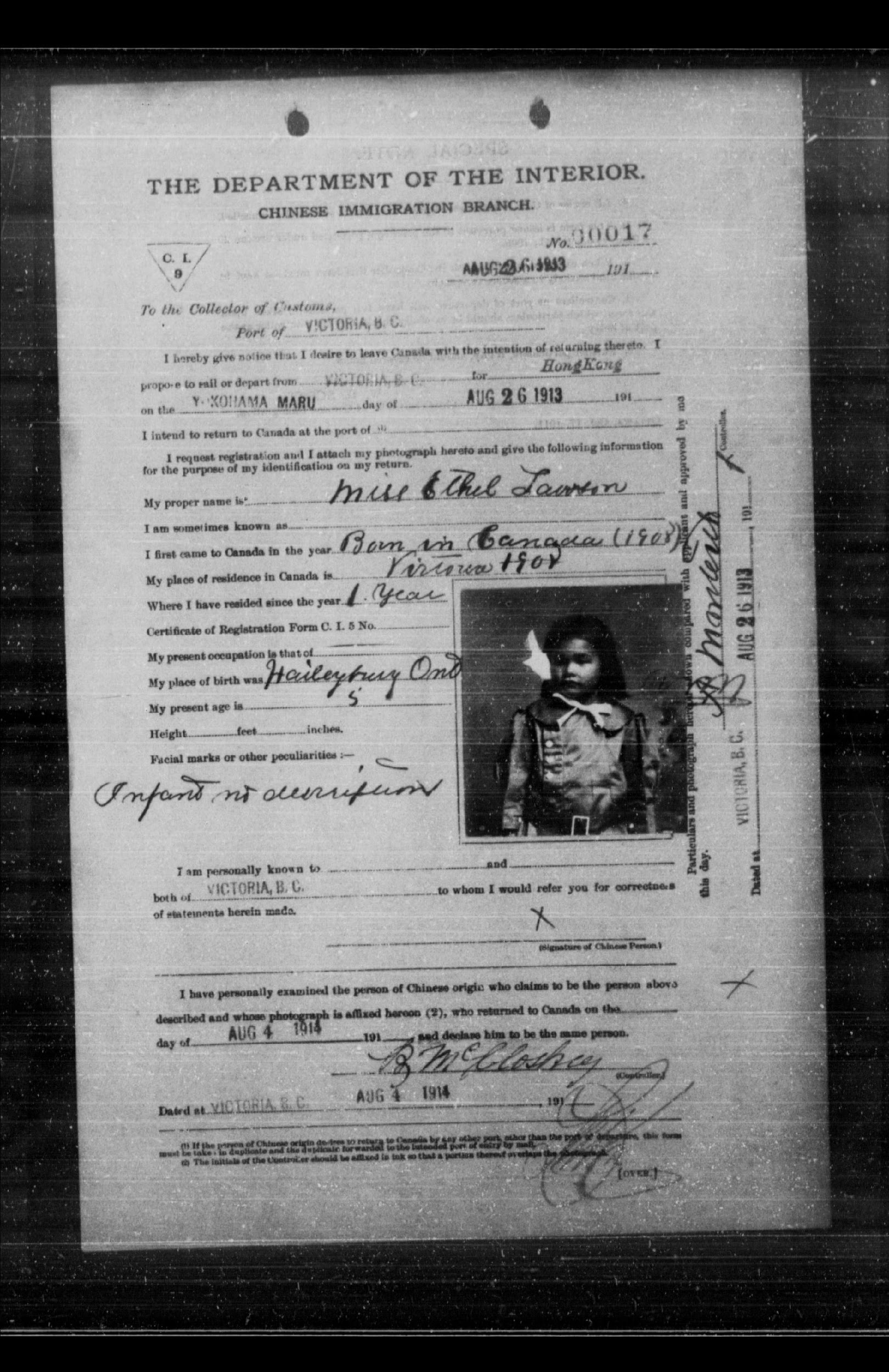
Here, Ethel is five years old. Her previous CI 9, no 17942, issued when she departed in 1911 on the Oanfa, shows that she returned to Canada, with both her parents, on 28 June 1912. They did not return with Pearl, James Jr, and Jane on this trip. The family would be reunited and return to Canada together, with two new additions, Pearl and Victoria, on 4 August 1914. James Jee Lawson and Mary Fuller had to get back to Canada before their CI 9s expired (two years after the date of issue). They brought Ethel but, for reasons we cannot know, took the risk of leaving three of their children behind. Pearl, James, and Jane would not rejoin the family until their journey to Canada in 1914. Indeed, the CI 9s that had been issued to James and Jane in 1911 had both already expired and been clearly marked as such. Fortunately, they were readmitted despite the expiration of their CI 9s.
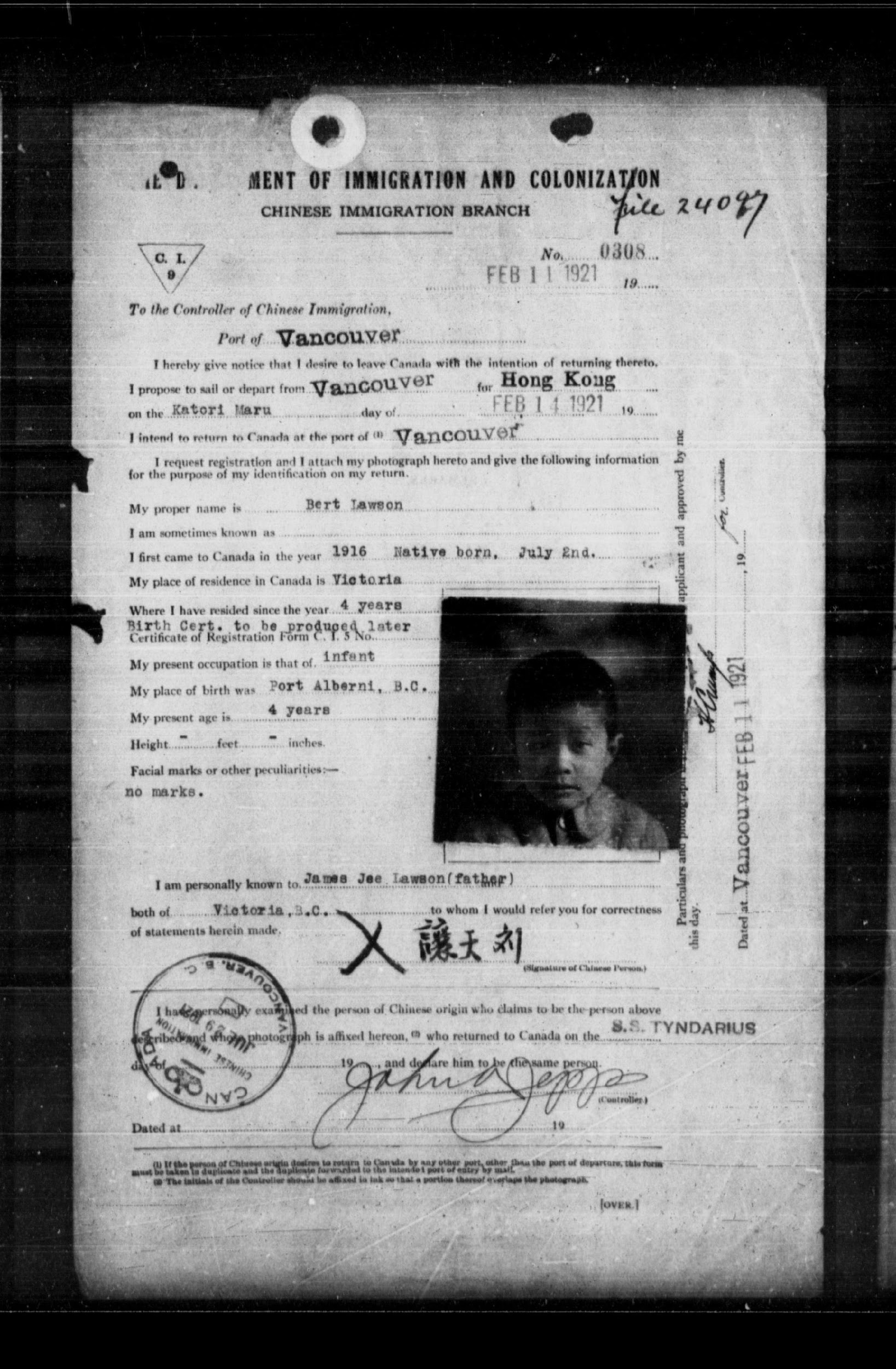
There is still one more member of the Lawson family in the CI 9 archive. When James Ying Choury Lawson departed from the Port of Vancouver on 14 February 1921 aboard the Katori Maru, he did so with four-year-old Bert Lawson (fig. 3.36). On CI 9 no. 0308, in the space where Bert is to provide the names of people to whom he is “personally known,” James Jee Lawson is identified as Bert’s father. Here, yet another geographic location to add to the complex map of places where the Lawsons have resided. Bert is born in Port Alberni, British Columbia. The identity of his mother is still a mystery. James Ying Choury Lawson and Bert Lawson sailed on the same ship but they did so without their parents and sisters. There are no CI 9s for a 14 February 1921 departure for James Jee Lawson, or Mrs Lawson, or for Ethel, Jane, Victoria, and Susan Pearl Oanfa.
Bert sails out with his older brother but the boys do not return together. James Ying Choury’s 1921 CI 9 notes that he returned to Canada on the Empress of Australia on 24 March 1924. Bert returns after only five months, on 29 July 1921 on the SS Tyndarius. There is no record of who accompanied him on this return journey. He would have just turned five. James Jee Lawson and Mary Catherine Fuller (and it is not necessarily the case that she is Bert’s mother – especially given that her obituary states that she had four daughters and only one son) were not recorded as having left Canada that year.
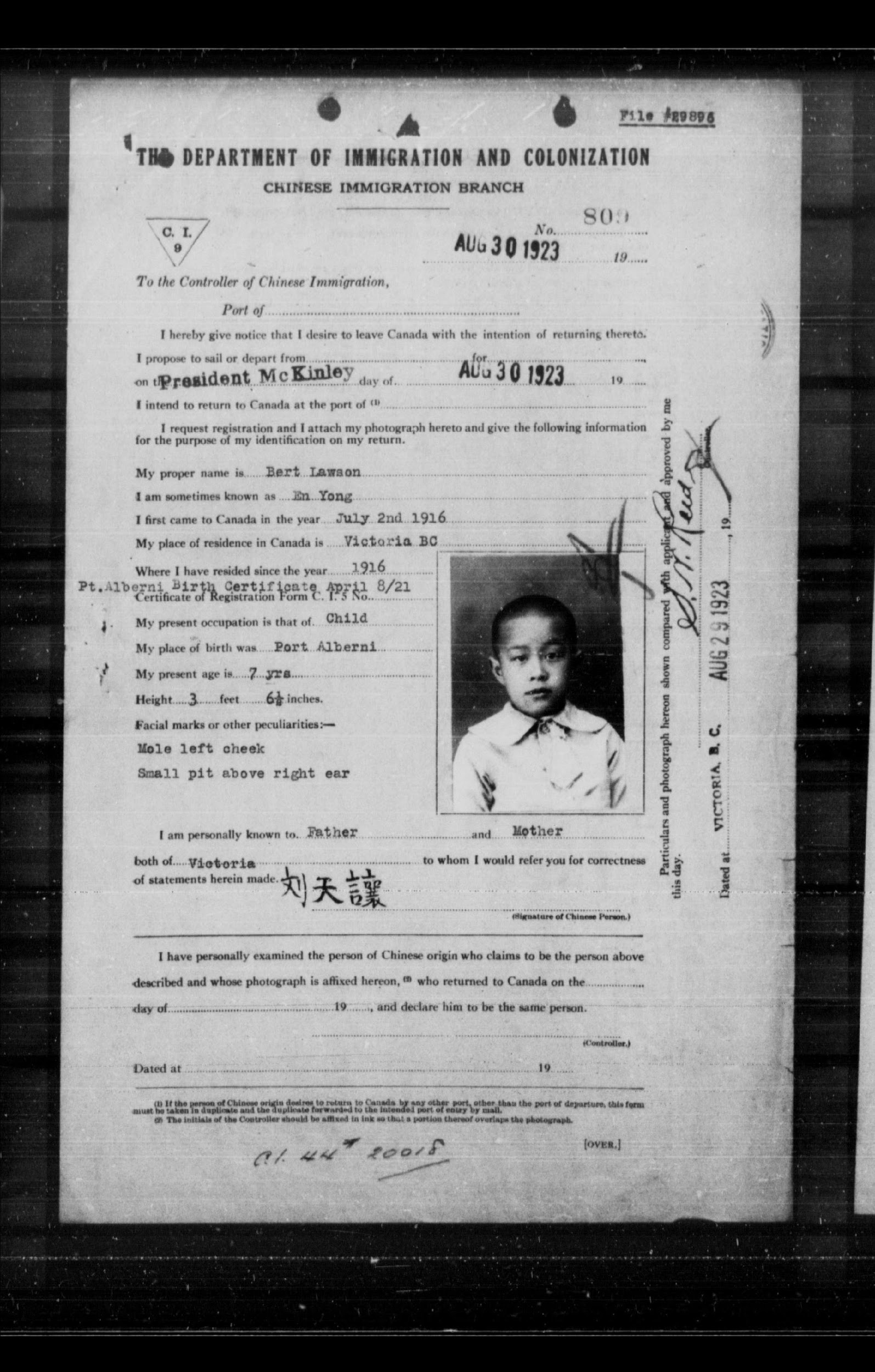
Bert resurfaces in the CI 9 archive two years later (fig. 3.37). He sailed out of the Port of Victoria on 30 August 1923 on the President McKinley. At this point in the records, the CI 9s for native-born Chinese children began to be filed separately from those of adults. He was not travelling with any of the other Lawson children, since there are no CI 9s issued for them departing at the same time. Nor are there any records of James Jee Lawson departing Canada on this ship on this day. Mrs Lawson née Fuller is not recorded as leaving Canada at this time.
There is much that remains a mystery about this little boy. Certainly, he had traversed the Pacific Ocean twice by the time he was seven years old. He did so without his father. His mother is also absent on these ships and in these records. There is no indication that he returned to Canada after leaving in 1923.
So much hovers on the edge of sadness for me about Bert Lawson. In this archive, he is the most peripheral, a small boy both times he appears. A minor detail that reveals a great deal about how Bert was torn away from what he knew: in 1921, even at the age of five, Bert had been taught to write his name in Chinese. Not only that, but he signs his name following the conventions of Chinese script with his surname, 刘, or “Lau,” written first from right to left. Two years later, when he leaves Canada seemingly for the final time, he still signs his name in Chinese, but has reversed the script. He has written his name with his surname first from left to right. Over the passage of two years, Bert Lawson consistently chooses to identify himself by signing his name in Chinese. In contrast, his father, James Jee Lawson, never signs his name in Chinese. But as he has aged, Bert has also become more Canadian. He has started to write from left to write instead of right to left. He is caught between two systems of writing, and two systems of identification (his name, and the CI 9 document). Sailing back and forth across the Pacific twice in two years, Bert is displaced again and again.
Strikingly, in the Lawson family, it is the sons who are cut away from family most forcefully by the cruel logic of the CI 9 forms. James and Bert are denied in different ways. James’s CI 9 takes away from him a surname that would have connected him to his father and his mother. Bert is allowed his father’s surname, but not the company of either one of his parents when he crosses the ocean four times as a young child. Bert is granted a connection to his father on a line in the form where he is identified as being “personally known” to his father, James Jee Lawson. But in both cases, the idea of the family is shorn from these boys. As Spillers understands, “‘family,’ as we practice and understand it in ‘in the West’ – the vertical transfer of a bloodline, of a patronymic, of titles and entitlements, of real estate and the prerogatives of ‘cold cash,’ from fathers to sons and in the supposedly free exchange of affectional ties between a male and a female of his choice – becomes the mythically revered privilege of a free and freed community” (74). The Lawsons were not enslaved. James Lawson has a family. He has a wife of his choosing. He has children. Still, their freedoms were severely limited. The record of their existence as a family reveals a persistent undermining of the fact of this family as a family. The head tax refused the sons access to the patronymic; it denied the transfer of titles and entitlements between fathers and sons. James Ying Choury does not appear to have a father or a mother until his re-emergence as James Lawson on CI 9 no. 0307 in 1921 (fig. 3.29). Bert’s patrilineage is permitted but only when he is separated from his father by dint of a long journey. Spillers argues that “captive persons were forced into patterns of dispersal” (75). The family that the Lawsons make is both their own and not their own. Their separations, either by the careless entry of a line on a form, or by the fact of a physical separation to which the form bears witness, are part of a larger pattern by which Chinese migrants lost their families repeatedly.
For the Lawsons, the CI 9s tell a story of making and remaking, of a family in near constant motion attempting to stay ahead of restrictions on their movements. Returning to the first set of CI 9s for the Lawsons, recording their departure aboard the Oanfa in 1911, we can see a family portrait within what I have argued is a larger portrait of the kinship of the ship itself. This family travelled together on that ship. But even a cursory look at their 1911 certificates already indicates how difficult it is to envision family and kinship in these certificates. To rely solely on the information contained in those 1911 CI 9s would have uncovered only part of the family that had been together on the Oanfa. James Ying Choury would seem to be, based on just his CI 9, a stranger child who was, at best, travelling in the company of the Lawson family. Susan Pearl Oanfa is not in the picture but had been present in that first photograph of Mrs Lawson. Finding this family demanded seeing beyond the CI 9s and looking for other evidence of their relatedness. Mass capture bound them together, as it did with every other Chinese migrant on the Oanfa in 1911, but it also visually fractures them. Siloed by their certificates, each member of the family has been cut away from the other.
White Women, Chinese Subjects
I want to conclude this chapter on looking for kinship in the CI 9 certificates by examining one more family travelling together aboard the Oanfa in 1911 (figs. 3.38 and 3.39). Here, on CI 9 no. 18001, is Mrs Fred Lun, or Lum, or Lau – without the Chinese ideogram for the name, it is hard to definitively decipher the handwriting. She is from Kingston, England. She is a housewife who was twenty-eight years old when she boarded the Oanfa. In the space for noting “facial marks and peculiarities,” the agent has written, “Scar under R Jaw” and “White Lady.”
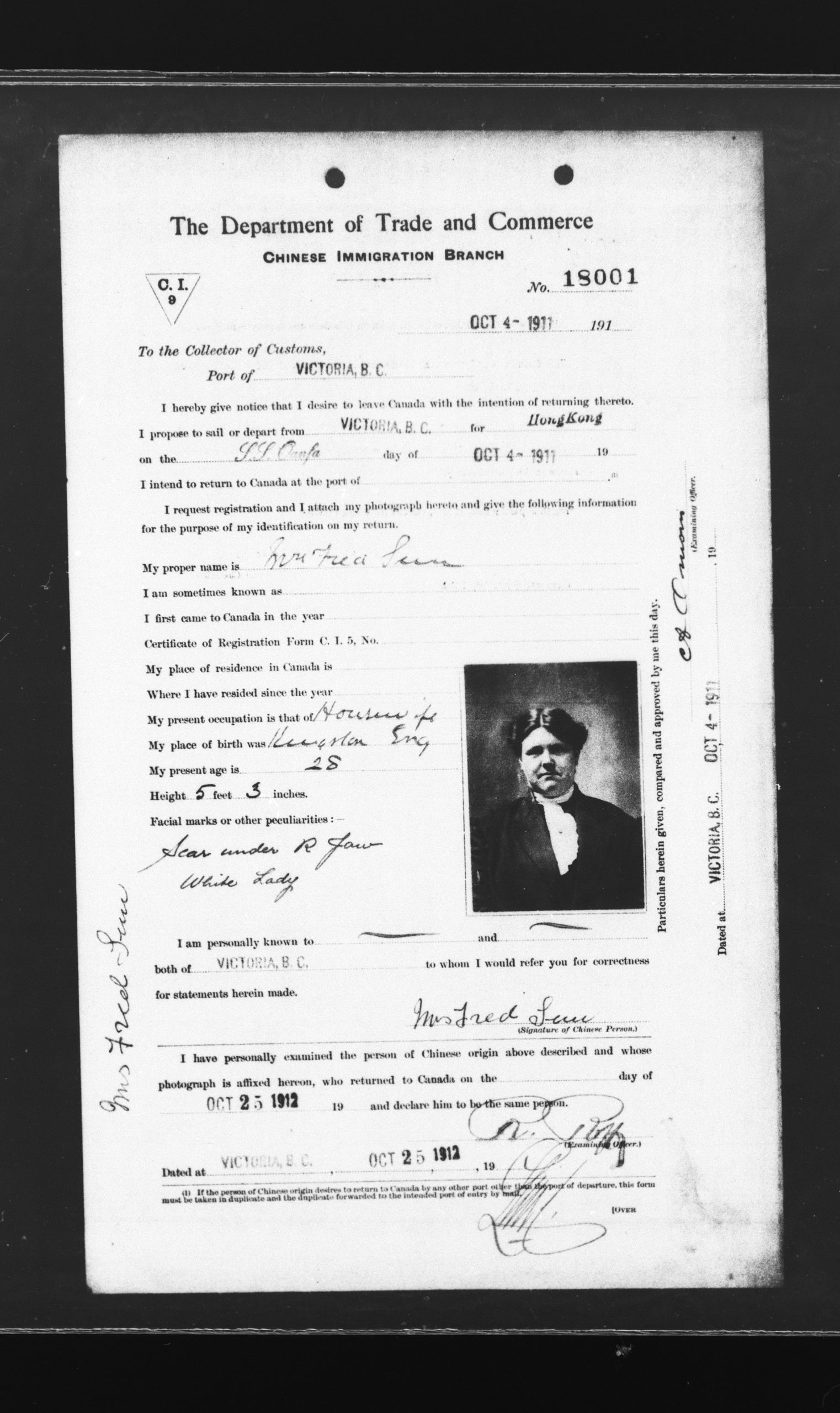
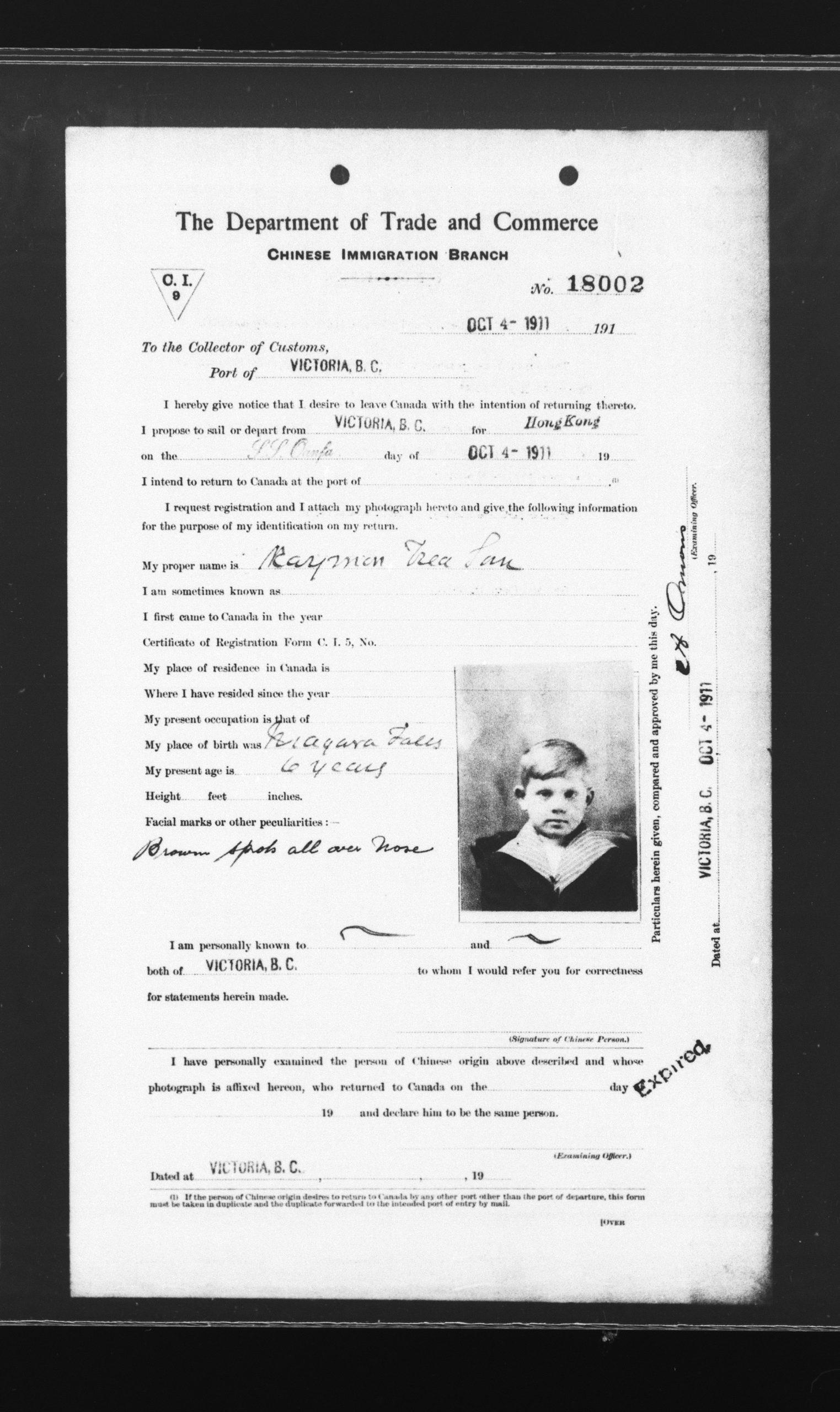
Although nothing on the CI 9 explicitly identifies the six-year-old boy in the subsequent certificate as her son, based on the surname it seems possible that Raymon Fred Lun, Lum, or Lau is travelling with his mother. He was born in Niagara Falls and has “brown spots” all over his nose. Nobody is identified as being “personally known” to him. Neither the certificate before 18001 nor the one following 18002 identifies a man who could be the father. CI 9 no. 18000 is for Lee Shei who claims to have been residing in and working as a labourer in Victoria for the last eleven years. CI 9 no. 18003 is for Jong Mou, who had been working as a farmer in Ashcroft, British Columbia for seven years prior to boarding the Oanfa.
Like the case of Mary Fuller, Mrs Lun does not enter this archive with any record of her maiden name. She can only be known here by her married name. Again, as with the Lawsons, the information on the certificates ties mother and child, but also separates them. The only geographic location on hers is Kingston, England, and the only geographic location on his is Niagara Falls. The photographs on CI 9 nos. 18001 and 18002 offer the possibility of familial relation at the same time that they deny it. In this double movement, of connection and the denial of connection, these two photographs resonate with Kunimoto’s reading of how the family photograph “entices but ultimately denies contact: reunion is offered but never actualized” (2004, 133). Although the identification photographs of Mrs Lun and Raymon Lun do not constitute a family photograph in the conventional sense, as I have been arguing, seeing them together does offer a portrait of togetherness for a group of people who were systematically denied so many forms of intimacy and familial relation. Still, even here, there is only the possibility of a reunion, of a mother and a child together.
Almost as soon as we can make out their togetherness, we are also left with the fact of their separation. Mrs Lun’s CI 9 notes that she returned to Canada on 25 October 1912. Raymon Lun’s CI 9 gives no return date. His certificate is stamped “expired.” She came back but he did not. Again, a family whose separation can be parsed through the cool objectivity of date and expiration stamps. There was a little boy who travelled with a woman who was most likely his mother. They were together. And then they were not. These certificates record their attachment and their separation.
Mrs Lun’s CI 9 is also another record of the bureaucratic transformation of a white woman into a Chinese subject. Such a transformation has already happened with Mrs James Jee Lawson on CI 9 no. 17939. Now, with CI 9 no. 18001, it becomes clear that this subjection of white women to the legislative regime of the Chinese Immigration Act is not a one-off. Both women are clearly identified as white. Both are definitely subjected to the legal demand that stipulated that Chinese migrants had to register through the CI 9 certificate system, before departing Canada. Such demands were not made of any other group of people living in Canada at this time. Canadian-born white women like Mary Fuller, or women from England like Mrs Lun, should have been exempt from this legislative demand. Yet, as CI 9 nos. 17939 and 18001 make clear, they had to register and provide an identification photograph like any other Chinese migrant. The CI 9s for white women in this archive are evidence of the extent to which white women who married Chinese men were treated as though they were Chinese. Their punishment for the families that they chose to make was to be swept into the net of mass capture.
To be clear, there is absolutely nothing in any Canadian statute that specifies that a white woman who marries a Chinese man should suddenly have to give up her whiteness. Still, this treatment of white women such as Mary Fuller and Mrs Lun echoes the “marrying out” rules that governed the identity of women under the Indian Act. Beginning in 1851 and lasting until these provisions were amended by the passage of Bill C-31 in 1985, the Indian Act deemed that non-Indigenous women who married Indigenous men would be considered “status” Indians. Relatedly, Indigenous women who married non-Indigenous men would lose their status under the provisions of the Indian Act, as would their children. Even though the Chinese Immigration Act never discusses the Chinese status of white women who marry Chinese men, CI 9 nos. 17939 and 18001 make very clear that white women married to Chinese men would be considered Chinese whenever they wished to travel outside of Canada with the intention of returning. They were considered to have “married out” not by statute, but by being captured within a process of exclusion that was blandly bureaucratic (complete this form, provide this identification photograph) and devastatingly regulatory. Because they were considered Chinese, there were restrictions placed on their movements. They had to return to Canada within two years of departure, and, as you can see from the return stamps on their forms, both women meticulously observed this regulation by returning before two years were up – even if it meant leaving again very soon to find children they had left behind (as was the case with Mary Fuller).
The CI 9s for white women, women who are explicitly identified as white and yet classified as Chinese by virtue of marriage to Chinese men, illuminate the way in which the mass capture of Chinese migrants also had consequences white Canadians. It makes visible a practice that had, until Mary Fuller and Mrs Lun surfaced in this archive, been unknown. Envisioning kinship under the conditions of mass capture uncovers the reach of the CI 9 system and how it captured whiteness in ways that were both gendered and racialized. As the textual material on the CI 9 certificates for Mary Fuller and Mrs Lun reveals, this system underwent all manner of contortions in order to mark these women as Chinese while also insisting upon their whiteness.
The position of white women marked as Chinese in the CI 9 archive also shows the complexities of the relationship between kinship and citizenship for Chinese migrants in Canada. With naturalization only accessible to some rare wealthy merchants, Chinese people in Canada could not be citizens until the repeal of the Chinese Immigration Act in 1947. By marrying Chinese men, Mary Fuller and Mrs Lun enter an in-between sphere where they may have been able to vote, but were unable to travel with their families without being marked as Chinese. They are very much, in Judith Butler’s terms, people whose “ontological status as legal subjects is suspended. These are not lives that are being genocidally destroyed, but neither are they being entered into the life of the legitimate community in which standards of recognition permit for an attainment of humanness” (2000, 81). Following Butler’s reading of citizenship and kinship through the figure of Antigone, these women’s access to “citizenship demands a partial repudiation of the kinship relations that bring the male citizen into being” (12). Mary Fuller and Mrs Lun are even farther removed than the figure of the gendered citizen in Butler’s discussion, because their kinship relations do not produce citizens. Their sons and daughters, as evidenced by the CI 9s they carried, were considered Chinese and did not have access to full citizenship in Canada. Mary Fuller and Mrs Lun both sailed on the Oanfa carrying CI 9s that signalled the Chineseness they acquired through marriage. We do not know if they were permitted into the parts of the ship reserved for white passengers or if they had to remain with others bearing CI 9s. Did their whiteness register differently at sea? At some point during that trans-pacific journey, they must have met. We cannot know what they might have said to each other, but we know that they share something in the papers they carried.
As a ship carrying migrants from Canada across the Pacific Ocean, the Oanfa is both typical and, as this chapter shows, exceptional. On this ship, as with so many others that are part of the CI 9 archive, the journey would have forged connections that were not there before, while also consolidating relationships that existed prior to its departure from port. In her discussion of family photography in China and its relationship to history, Laura Wexler writes: “Photographs have a privileged relation to memory, which brings issues of recollection to the forefront of every photographic image. As theorist after theorist has demonstrated, photographs draw us into what we know so that we can recognize what we have forgotten, or refused to see” (2011, 9). Although Wexler’s argument emerges out of her research on the circulation of family photography in contemporary China, her discussion can be expanded from the function of memory within a single family to its function within the nation and the diaspora. The photographs of families in the CI 9 collection feature only a handful of people, but they nonetheless demand their beholders to consider that which has been forgotten or discounted, particularly in terms of the destructiveness of the policies of racial exclusion.
The CI 9 certificates demand a different envisioning of kinship than that of a conventional family photograph where members of a family are pictured together in a single frame. Here, kinship is formed despite the devastating denial of intimacy that the Chinese Immigration Act encodes through its restrictions on the entry of Chinese of migrants and the regulations governing their mobility. We can see families fractured both visually, through the visual siloes of their identification photographs, and physically, in the records of their movements. This chapter looks for kinship despite laws and regulations that actively separated Chinese migrants from their families. Seeing through this persecution and into the bonds of the shipboard journey, and looking for families whose connections have been lost or obscured, is the task of envisioning kinship for Mass Capture.
